The perfect Europe Christmas market itinerary by train
Some links in this post are affiliate links, which means I earn a small commission if you book through them, at no extra cost to you. This support helps keep this site running, the suitcase wheels spinning, and lets me keep writing ultra-detailed travel guides that are free for you to use to plan your next adventure.
Want a true festive adventure hopping between Europe’s best Christmas markets without the stress of flying during the holiday season? This Europe Christmas market train itinerary shows you how to visit the most magical markets in Germany, France, Austria and beyond, all by train.
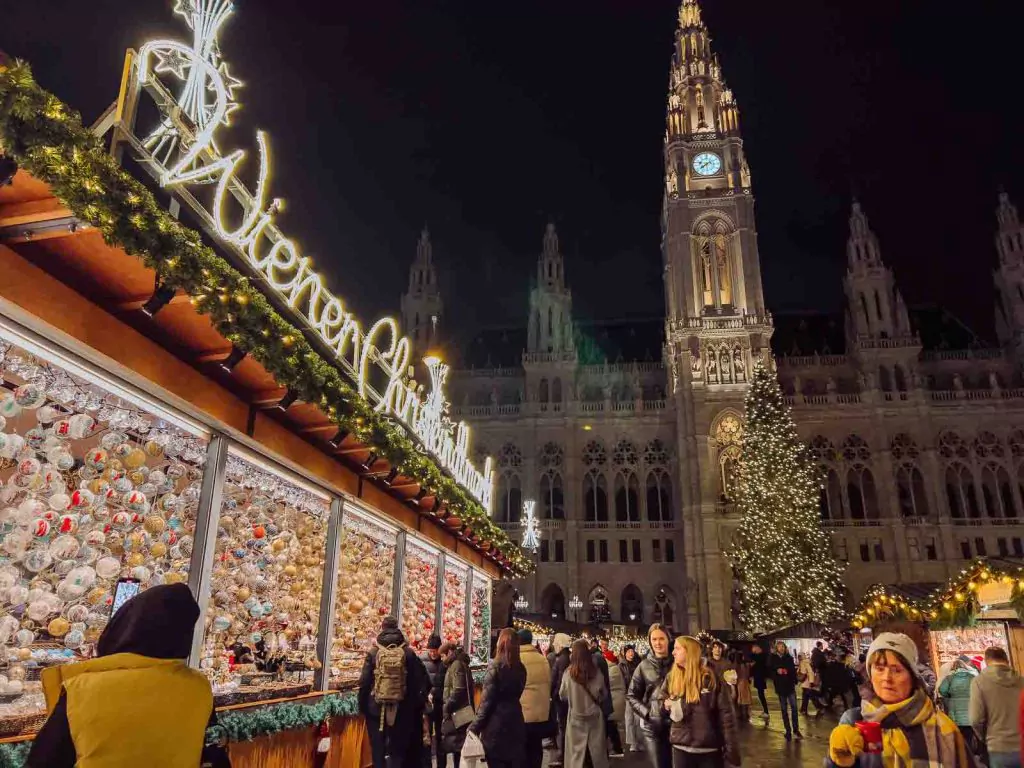
As the temperature drops and the days get shorter, Europe’s Christmas markets come alive with dazzling light displays, artisan gift stalls, steaming mugs of Glühwein and hearty snacks that’ll put you in an immediate food coma.
What started in Germany in the Middle Ages has transformed into a continent-wide celebration, but not all markets are created equal. Some feel like you’ve stepped straight into a snow globe, others are total tourist traps, and trying to figure out which ones are worth it (and how to connect them) can be a logistical nightmare.
I’ve spent the past few years chasing Christmas market magic across Europe, visiting over 40 markets in 20 cities and 13 countries, and this itinerary is the result of allllll that research (and an alarming number of spiced rum hot chocolates).
The full Christmas market itinerary route I’ve recommended covers 14 cities in five countries, ticking off the most iconic and authentic markets in Germany, France, Austria and more, all easily connected by scenic and stress-free train travel.
Inside this mega guide you’ll find:
- The best markets in each country with confirmed dates and links to official announcements
- A flexible 7-21 day route plus options to shorten it if you’re tight on time
- Exact train routes to get from A to B and some worthwhile stopovers on the way
- Budget advice and tips for things like Eurail/Interrail passes, Europe eSIMs and more
- Local experiences beyond the bretzels and baubles, so you can enjoy some non-Christmas sightseeing too
- My personal tips on what’s worth the hype and what’s not
- Recommendations on where to stay in each destination for easy access to the markets

So pop on some Christmassy music, get out your travel planning notebook and lets run through the perfect itinerary for seeing Europe’s Christmas markets by train.
At a glance: Europe Christmas market train itinerary
Christmas market itinerary summary
- Arrive in Frankfurt
- Cologne day trip
- Nuremberg day trip
- Frankfurt to Strasbourg
- Colmar day trip
- Strasbourg to Basel via Mulhouse
- Basel to Innsbruck via Zurich
- Innsbruck to Salzburg
- Salzburg to Vienna
- Bratislava day trip
- Vienna to Prague
- Prague to Dresden
- Depart Dresden or return to Frankfurt to fly out

Christmas market itinerary map
Quick links
- The Europe eSIM I always use: MobiMatter (way cheaper than the big brands and works perfectly, get extra cashback with promocode FINDINGALEXX)
- Save up to 10% on your Eurail or Interrail Pass through Klook with promocode FINDINGALEXXKLOOK (and they have a better cancellation policy than booking direct!)
- I use Wise for all my daily spending on the road, super easy to convert currencies and track your spending on the go
The ultimate Europe Christmas market train itinerary
How long will this itinerary take?
The ideal length of time to follow this European Christmas market itinerary would be 2.5 weeks. This amount of time lets you spend at least one full day in 12 different iconic Christmas market cities, and also allows some downtime for easy stops on the way as well as non-Christmas sightseeing.
If you need a shorter trip you could just choose a section of this itinerary and head to those few places instead. I’ve got some suggestions for one week trips below the itinerary.
And if you’ve got more time, you could either slow it down and spend your time in some of these cities, or opt to add on some new ones instead. I’ve got suggestions for potential add ons at the bottom of the itinerary too, or you could check out my epic itinerary for three months in Europe and use that to create the ultimate route for your trip.
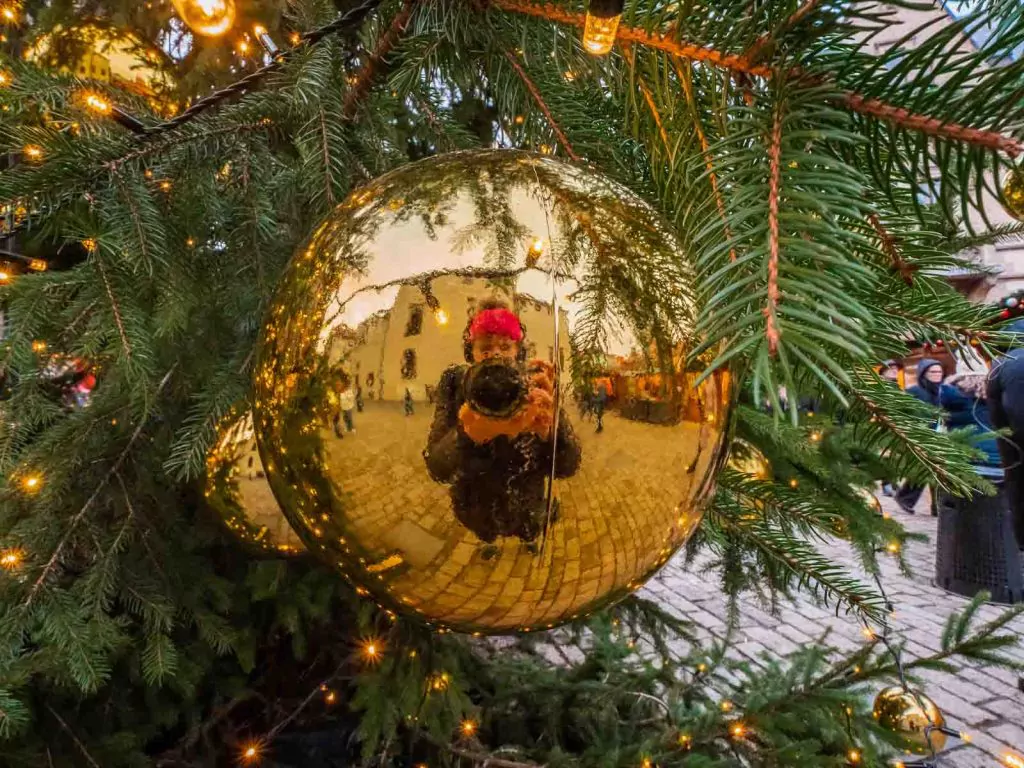
Who is this itinerary for?
This Europe Christmas market itinerary is for:
- Travellers from outside Europe who want to make the most of visiting Europe in winter
- Christmas addicts who are obsessed with festive vibes and are happy to brave the crowds
- Foodies who want to try different culinary treats
- Keen train travellers who love a flight-free adventure
This Europe Christmas market itinerary is not for:
- People with only a few days, if you’ve only got a weekend or extended weekend then I’d suggest choosing one hub like Strasbourg, Frankfurt or Salzburg and then doing maybe one day trip from there (Colmar, Cologne or Innsbruck as examples)
- Travellers who hate crowds or cold weather
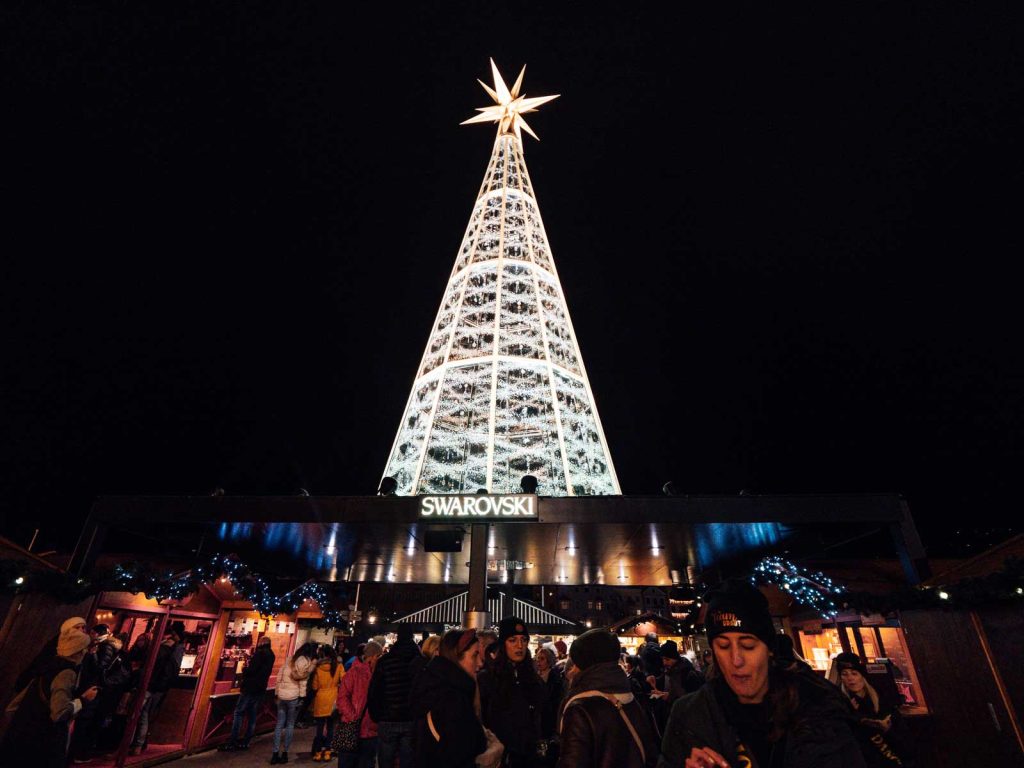
Where does this European Christmas markets train itinerary start?
This train itinerary can easily be made into a loop by connecting Dresden and Frankfurt, so you can start and end anywhere you want.
I’d suggest researching the cheapest cities to fly in and out of and then planning your route from there. Typically you’ll find the cheapest flights in and out of major hub cities like Frankfurt, Vienna and Prague.

Do you need a Eurail/Interrail Pass for this trip?
You don’t need one, but if you’re following this route then you might find that it saves you money and gives you flexibility!
If you have a Eurail Pass or Interrail Pass then you can take any no-seat-reservation-needed train without needing to pre-book, and that’s most of the trains I’ve mentioned in this itinerary. That means you can just turn up at the station whenever you’re ready and jump on the next train available.
For some trains (particularly high-speed trains in France) you need to make a reservation in advance, but this is still usually much cheaper than paying full price for a ticket during high demand times.
I’ve listed the seat reservation details for all of the train journeys in this itinerary, to find out definitively whether a pass is worth it would require searching each route on the correct date and noting down the price, this way you can compare the total of individual tickets vs. the pass price plus any seat reservations.
And if you’re ready to buy your rail pass, book through Klook to get a better cancellation policy than booking direct (full free cancellation until you activate the pass, vs. direct with Eurail who charge a 10% cancellation fee).
No idea what I’m talking about? Learn about Eurail/Interrail Passes (and how they can save you loooads of money) in my Eurail guides:
- Is a Eurail Pass worth it?
- How to use a Eurail Pass
- The ultimate three month Europe itinerary (no car needed)
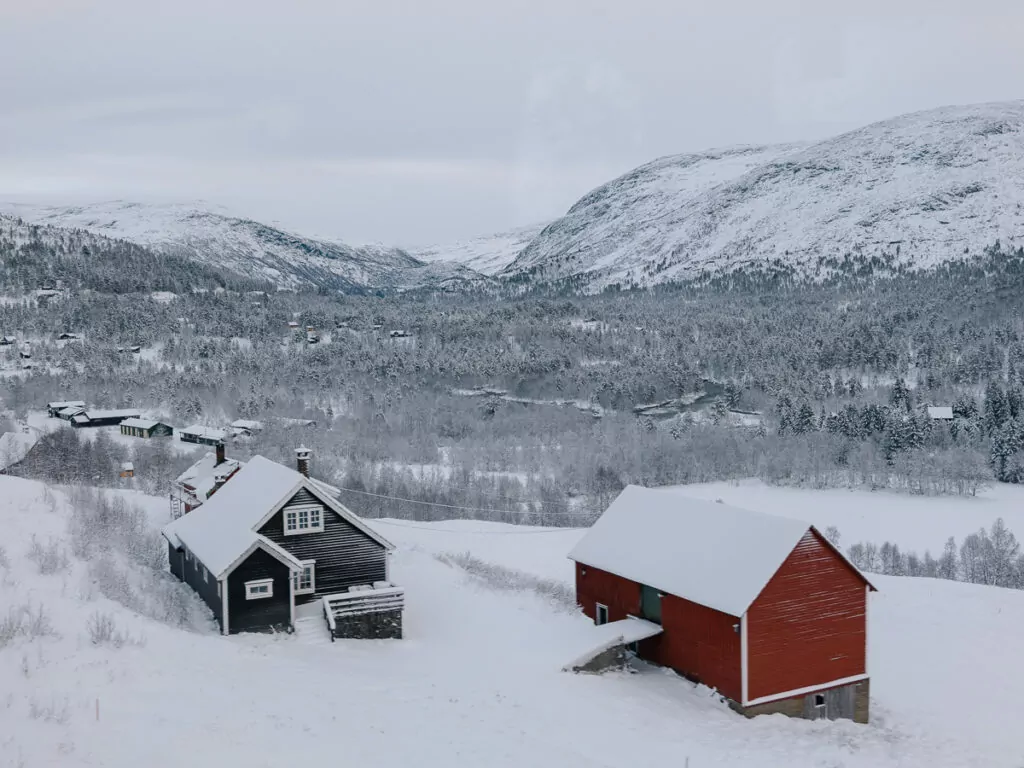
Train views during winter in Norway
Europe Christmas market itinerary: Day by day
Day 1: Frankfurt
Frankfurt Christmas market dates for 2025: 25 November – 22 December (official info here)
While Frankfurt is best known as Germany’s financial hub, the city’s Christmas markets are a melting pot where old German tradition and modern cosmopolitan culture collide.
The historic Römerberg square transforms into a charming winter wonderland, with lavishly decorated stalls, the scent of freshly roasted chestnuts wafting through the air, and a giant Christmas tree towering above the crowds of market-goers. There’s an extravagant two-level carousel for kids or the young at heart, just be careful if you’ve been indulging in Glühwein or alcoholic hot chocolates or your head will spin for hours!
There are other stretches of markets that are easily reached by foot, many are a bit less authentic with food stalls serving international cuisine like gyoza and bao buns, Peruvian tamales and even curries and dahls.
It’s also one of the best European cities for Christmas market day trips, with easy access by train to Cologne, Nuremburg and more!
CHRISTMAS MARKET TIP: You may have seen photos of Christmas-themed mugs, ones shaped like Santa’s boot or with a gnome on the front? These mugs are what your hot drinks will be served in throughout all of the Christmas markets in Europe, you pay a cup deposit (usually €3-5) and then get your money back when you return the cup. Or if you want to keep it as a souvenir, wash it out with water and pop it in your bag!
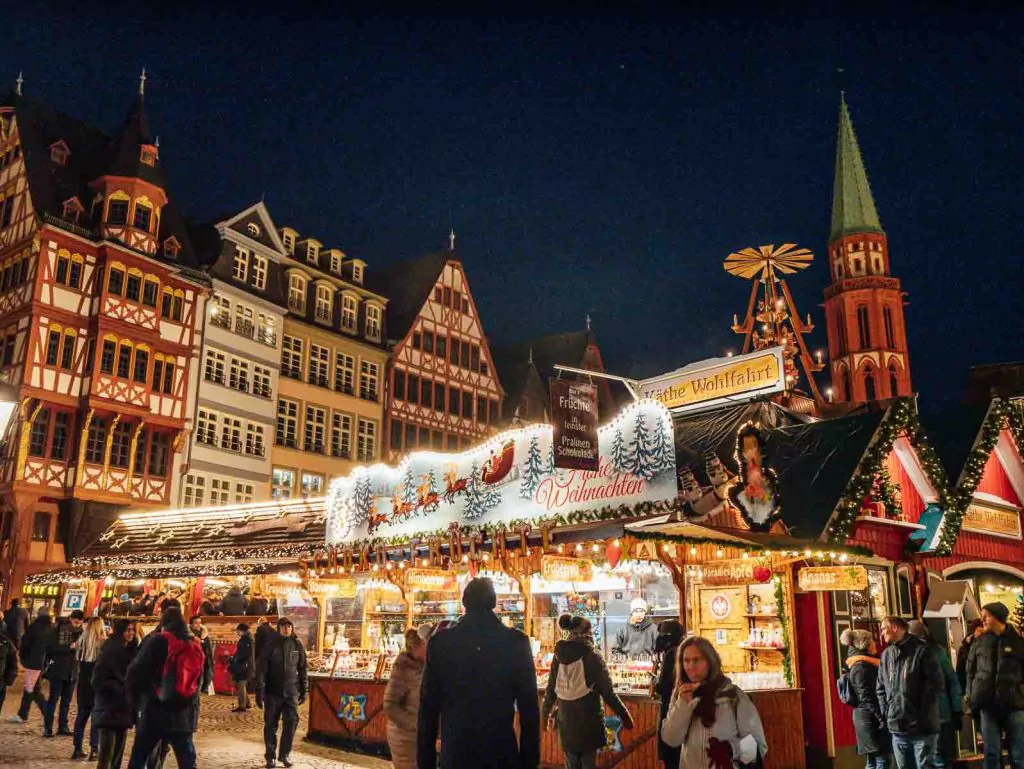
Other things to do in Frankfurt
- Visit the Museum District, where you can find museums for natural history, modern art and German culture
- Take a food tour to learn about Frankfurt’s diverse gastronomic scene
- See the city from a river cruise
Where to stay in Frankfurt
Budget | I stayed at MEININGER Frankfurt Airport, a hotel/hostel hybrid that offers affordable dorm rooms and private rooms, along with access to a shared kitchen, laundry facilities and work-friendly spaces. Basic but very comfortable, and in a great location just a short walk from an S-Bahn station that’s just ten minutes from the middle of the city.
Mid-range | Motel One Frankfurt-Romer is right in the middle of the action, the Blasky is a funky boutique hotel, Melia Frankfurt is on the fancier end of mid-range or Studiohouse has beautiful self-contained apartments
Luxury | The Sofitel Frankfurt Opera, Roomers, Steigenberger Icon and the JW Marriott are all top-rated five star luxurious options
Check rates and availability for your Frankfurt travel dates at booking.com >>
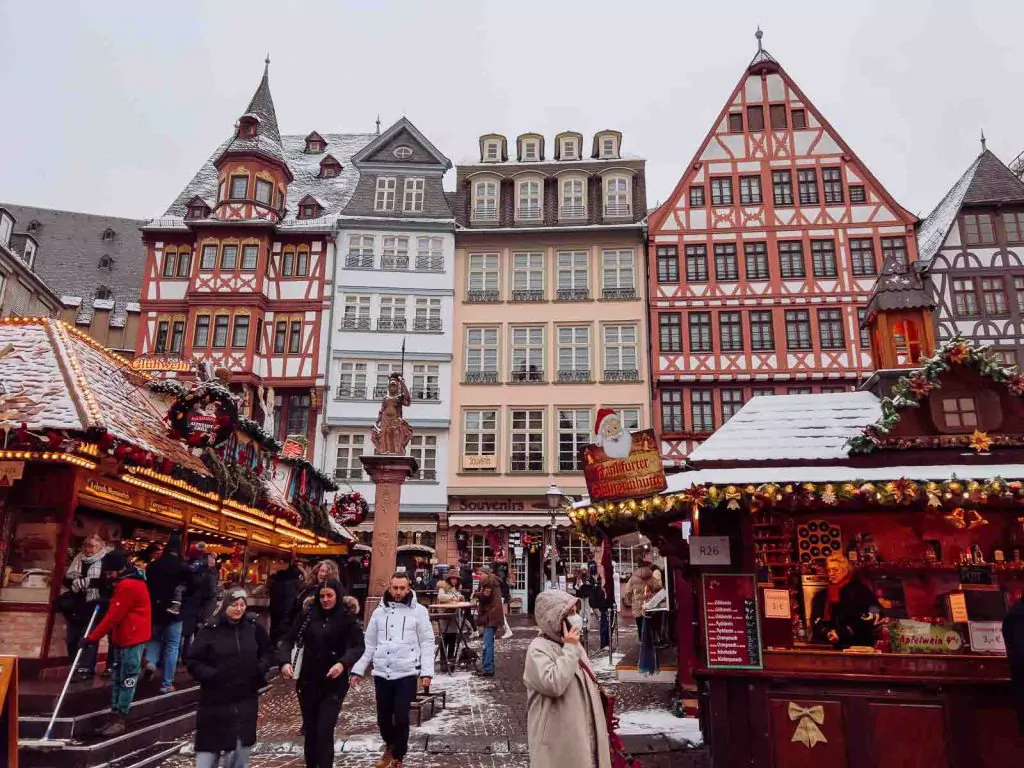
Day 2: Cologne day trip from Frankfurt
Cologne Christmas market dates for 2025: 17 November – 23 December for the main markets at the cathedral (smaller markets have different dates, official website here)
How to get to Cologne from Frankfurt
Direct trains run often throughout the day and take between 1h 5m and 1h 25m, no reservation needed if you’re travelling with a Eurail/Interrail Pass.
About Cologne
Cologne’s Christmas market is a full day affair, so I’d recommend catching an early train and coming back after dinner.
The main market sits next to the monumental Cologne Cathedral, the largest Gothic church in Northern Europe, and you’ll be able to enjoy classic German winter treats like reibekuchen (potato cakes), currywurst and gingerbread. There’s a big stage here with live music and other entertainment during most evenings, and it’s beautifully decorated with strings of thousands of lights sparkling above the crowd.
There are many more Christmas markets dotted through the city which might be daunting, but they’re easily navigated by foot and you can follow the crowds of people walking between them, there’s no chance of getting lost!
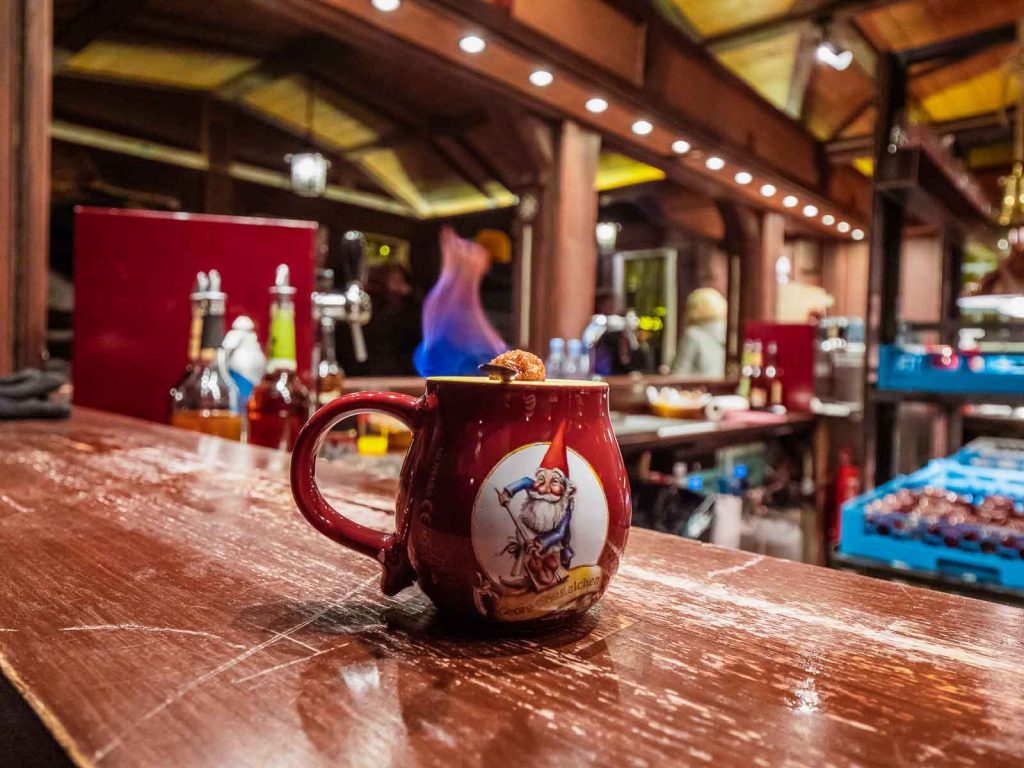
Markt der Engel (Angels’ Market) is known for rustic cabin stalls, cute paper decorations in the trees and literal angels with wings wandering around the market.
Nikolausdorf can be found by walking through the 13th century Hahnentor gate at Rudolfplatz, and the market is cute and cosy with family-focused stalls and sweet treats.
But my favourite Christmas market in Cologne was Heinzels Winter Fairytale, where you can ice skate, watch local woodworkers create hand-carved souvenirs, and indulge in culinary delights. Don’t miss out on trying feuerzangenbowle here, a flaming punch that’s made by soaking a sugar cone in rum and setting it alight over top of a cup of Glühwein. DELISH.
You could spend a night in Cologne if you wanted to but the city gets very busy during the Christmas market season and hotel prices skyrocket, so doing a day trip from Frankfurt will probably save some money.
Other things to do in Cologne
- Get amongst the city’s infamous street art with a walking tour or bike tour
- Visit some of the breweries to taste test local beer or do a brewery tour
- Do a harbour cruise
TRAVEL TIP: If you need to get out cash to use at the market, do not use the ATMs in the train station. These will charge you a fee for international cards, about €4! Instead walk out of the train station, and you’ll see a BB Bank on the corner of the road that’s to the front-right of the train station. These ATMs charge no fees for international cards. You’re welcome!
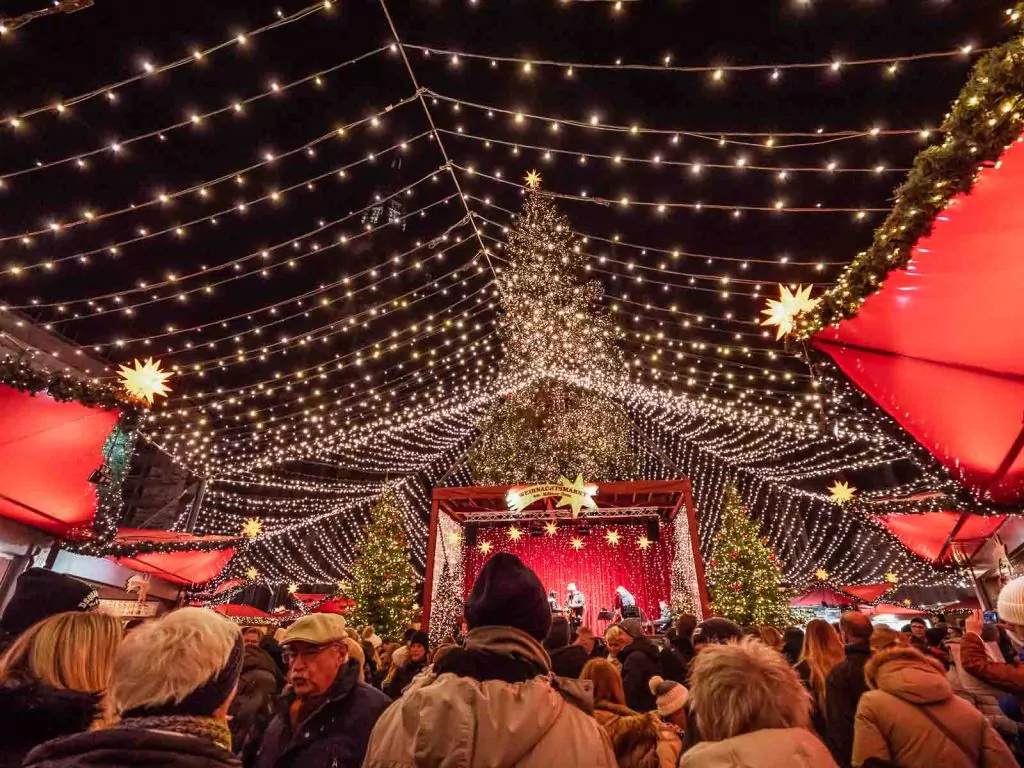
Day 3: Nuremberg day trip from Frankfurt
Nuremberg Christmas market dates for 2025: 28 November – 24 December (official website here)
How to get to Nuremberg from Frankfurt
Direct trains run throughout the day and take just over two hours, no reservation needed with a Eurail/Interrail Pass.
About Nuremberg
Nuremberg’s Christkindlesmarkt dates back to the 16th century, and these days it attracts more than two million visitors per year looking to get their festive fix. This market is certainly one of the most photogenic Christmas markets in Europe, the little wooden stands are topped with candy cane striped tarpaulins, you can pick up one-of-a-kind locally designed arts and crafts, and the food stands will have you drooling.
Don’t leave without trying Nuremberg Lebkuchen (giant gingerbread) and a Weggla, a circular bun with three Nuremberg bratwurst sausages inside.
You could spend a night in Nuremberg if you want to see the markets over two days, but once again you’ll need to book accommodation in advance to get a decent deal, and you’ll need to go via Frankfurt or Karlsruhe to get to Strasbourg which is the next stop on your Christmas in Europe itinerary.
Other things to do in Nuremberg
- Do a Christmas culinary tour to taste all the best Christmas treats
- Explore the city’s medieval dungeons
- Go underground with a WWII bunker tour

Day 4-5: Strasbourg
Strasbourg Christmas market dates for 2025: 26 November – 24 December (official website here)
How to get from Frankfurt to Strasbourg
Direct trains run a few times a day and take 1h 55m-2h 5m, and there is a seat reservation fee of €19 for Eurail/Interrail Pass holders as it’s a high-speed train in and out of France. If you don’t want to pay a seat reservation fee you can take a two-train journey with a stop in Offenburg, this is only about 2h 15m and uses a regional train into France which doesn’t require reservations.
About Strasbourg
The self-proclaimed (but fair!) Capital of Christmas is home to the oldest Christmas market in France, which has been serving Christmas cheer since 1570. The small city has 13 Christmas markets dotted around the Grande Île (the old town surrounded by a canal), where you’ll be able to experience a captivating blend of French and German traditions, cuisine and Christmas events.
The light displays in Strasbourg are worth a trip alone, some must-sees are the grand Strasbourg Cathedral being illuminated behind the main markets, Petite France’s themed installations down different alleyways, and the 30m high Christmas Tree which you’ll find at Place Kléber Square. See if you can find the famous Teddy Bear House too!
In Strasbourg you’ll be able to indulge in traditional Alsatian cuisine like cheese-covered bretzels, a delicious flatbread pizza called a flammekueche in German or tarte flambée in French, or little pastry puffs called chouquettes.
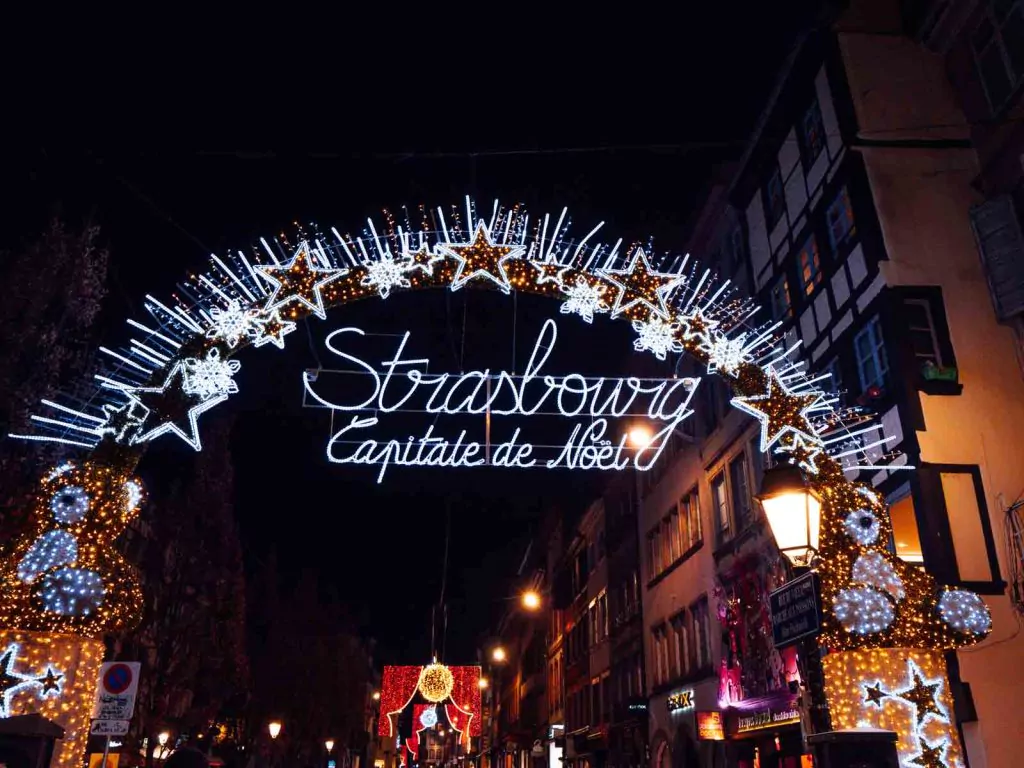
Where to stay in Strasbourg
Budget | I stayed at People Strasbourg, a fancy hostel just a seven minute walk from the main market. The hostel has a great pod-style set up but unfortunately there’s no kitchen which meant I ended up spending lots of money on food. There aren’t any other decent hostel options in Strasbourg, but for an affordable hotel you could check out Hotel F1 or Néméa Appart-Hôtel Elypséo (both slightly out of the city).
Mid-range | Citadines Eurometropole, K Hotel and Best Western Plus Monopole Métropole are all top-rated, good value options
Luxury | Maison Rouge Strasbourg, Hôtel LÉONOR and Hotel Cour du Corbeau are the best-rated luxury hotels in town
Check rates and availability for your Strasbourg travel dates at booking.com >>

Day 6: Colmar day trip
Colmar Christmas market dates for 2025: 25 November – 29 December (official website here)
How to get from Strasbourg to Colmar
There are direct regional trains constantly throughout the day that only take 30 minutes, no reservation needed for rail pass holders but only €14.10 each way so super cheap (and not worth using a Eurail travel day if you have a flexi pass).
About Colmar
Colmar’s enchanting Christmas markets are straight off a postcard, you’ll see colourful houses decked out with festive frills, beautiful light displays reflecting in the canals, and even makeshift Christmas scenes like little gnome houses.
There are six Christmas markets to explore in Colmar’s historic centre with a total of 180 stalls to discover, selling seasonal sweets, local artwork, festive decorations and more.
My favourite part of the Colmar Christmas markets was the Marché Gourmand (gourmet market) at Place de la Cathédrale, where you’ll find renowned eateries and expert chefs serving up culinary magic for an incredibly affordable price. You could get a truffle risotto for only €11 and other fancy dishes for less than €15.
Despite being so gorgeous and popular, Colmar is actually one of the cheapest markets on this Europe Christmas itinerary. You can expect to pay €2.50-€3 for a vin chaud (mulled wine), €2.50 for a sugar crepe and €6 for a hearty hot dog.


About Eguisheim and Riquewihr
There are some smaller markets in Alsace that are worth a visit if you want to escape the commercialised craziness, especially the picturesque markets of Eguisheim and Riquewihr. They don’t have train stations unfortunately but you can reach them with a short bus trip from Colmar if you’d like to visit two or three different market towns in one day. Eguisheim is 16 minutes away by bus and Riquewihr is a 28 minute bus trip.
Colmar accommodation is very limited so I’d recommend heading back to Strasbourg to stay the night before moving on to your next stop.
Day 7-8: Basel via Mulhouse
Mulhouse Christmas market dates for 2025: 24 November – 27 December (official website here)
Basel Christmas market dates for 2025: 27 November – 23 December (official website here)
How to get from Strasbourg to Basel
Direct regional trains run about every half an hour throughout the day and take 1h 20m in total, no seat reservation required for rail pass holders.
About Mulhouse
The Strasbourg to Basel train goes via Mulhouse, so I’d recommend getting off the train, paying to store your luggage at the station and seeing Mulhouse’s markets before continuing through to Switzerland.
Mulhouse’s Marché de Noël pays homage to the city’s rich history of textiles and patterns, and you’ll see locally-designed and printed fabric draped from façades throughout the colourful old town. If you want to get souvenirs for friends and family back home, Mulhouse has some of the most beautiful gifts to choose from, including jewellery, clothing, hair accessories, bags and more.

About Basel
Basel is one of Switzerland’s largest Christmas markets and without a doubt one of the prettiest, with exquisite decorations, magnificent light displays and charming wooden cabins offering homewares, souvenirs and culinary delights.
Sip mulled wine and spiced hot chocolate, enjoy sugary apple fritters, or try a chäsbängel, which is a baguette filled with melted fondue cheese, a.k.a. my dream food.
Be sure to head up the stairwell of St Martin’s Tower to get the best view of the lights and markets, tickets are 6CHF and the last entry is at 5.30pm.
Other things to do in Basel
- Discover the city’s up-and-coming craft beer scene
- Take a walking tour through the Old Town
Where to stay in Basel
Budget | SILO Design Hostel is my absolute fave in Basel, it’s a short walk from Bad station and is ideal for digital nomads and remote workers wanting a creative space to work and chill while travelling. For a more social scene there’s Basel Youth Hostel, or Guesthouse Casa Esperanza is a cheap but very popular guesthouse.
Mid-range | BLOOM Boutique Hotel, GAIA Hotel and HYVE Hotel & Lounge
Luxury | Grand Hotel Les Trois Rois, Hotel Märthof Basel and ART HOUSE Basel
Check rates and availability for your Basel travel dates at booking.com >>

Day 9-10: Innsbruck via Zurich
Zurich Christmas market dates for 2025: 20 November – 23 December (official website here)
Innsbruck Christmas market dates for 2025: 15 November – 23 December (official website here)
How to get from Basel to Innsbruck
Your first leg is Basel to Zurich, a direct train that takes between 55m and 1h 10m, no seat reservation required for Eurail Pass holders.
You can either choose to store your luggage at the train station and stay in Zurich for the day to explore the city and its markets, or just switch to a Zurich to Innsbruck direct train which runs every two hours, takes 3h 30m, and doesn’t require a reservation.
About Zurich
Zurich is a super scenic city that’s definitely worth a day trip en route to Innsbruck. Store your luggage in the lockers at the train station and make your way to the Christmas market in the city’s historic Old Town, where you’ll be able to samples Swiss specialties like chocolate, cheese and wine as well as the usual Christmas market delicacies you’ve come to love while travelling through Germany and France.
My fellow cheese connoisseurs need to visit the fondue chalet, a cosy wooden cabin serving up melted goodness. Divine!
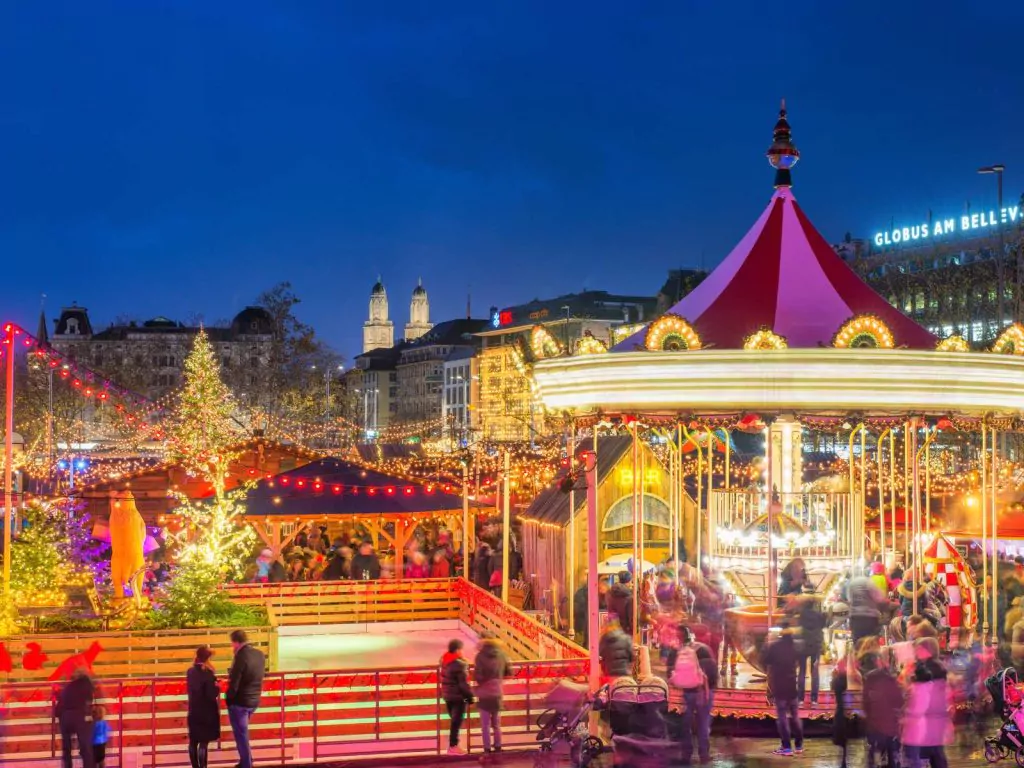
The reason I haven’t included a night in Zurich is because it’s one of the most expensive cities in the world, so a day trip gives you the chance to see the city and markets without having to splurge on Zurich accommodation, butttt if you do choose to spend a night here then my favourite hotel in the city is B2 Design Hotel, look at their incredible library room 😍
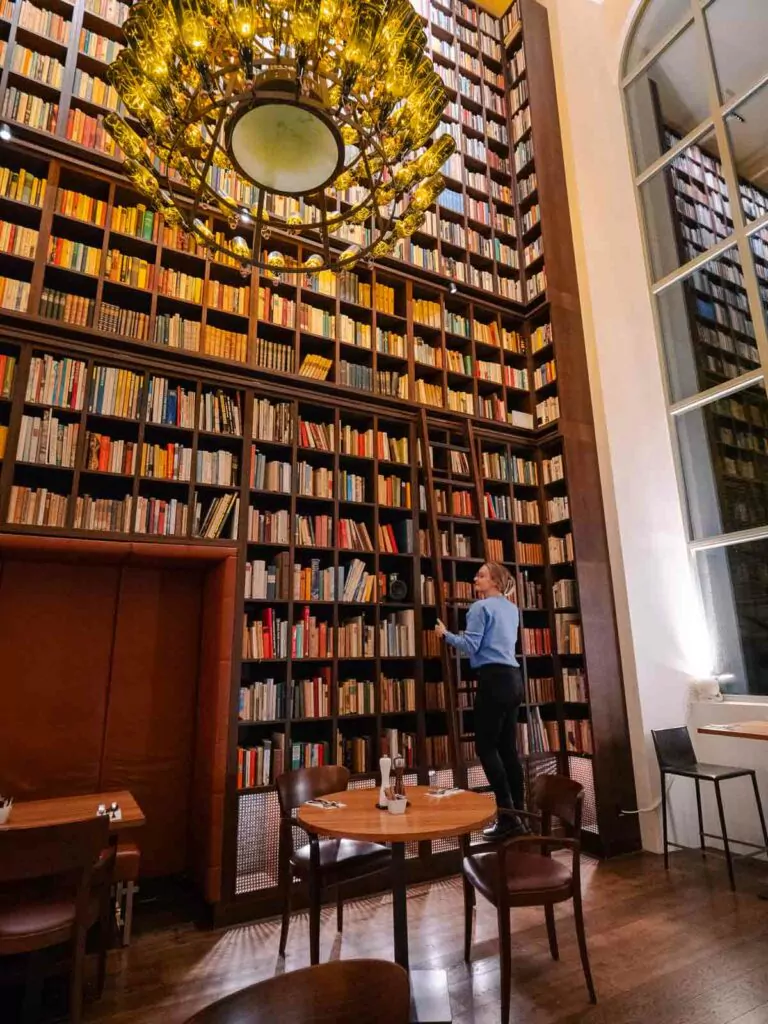
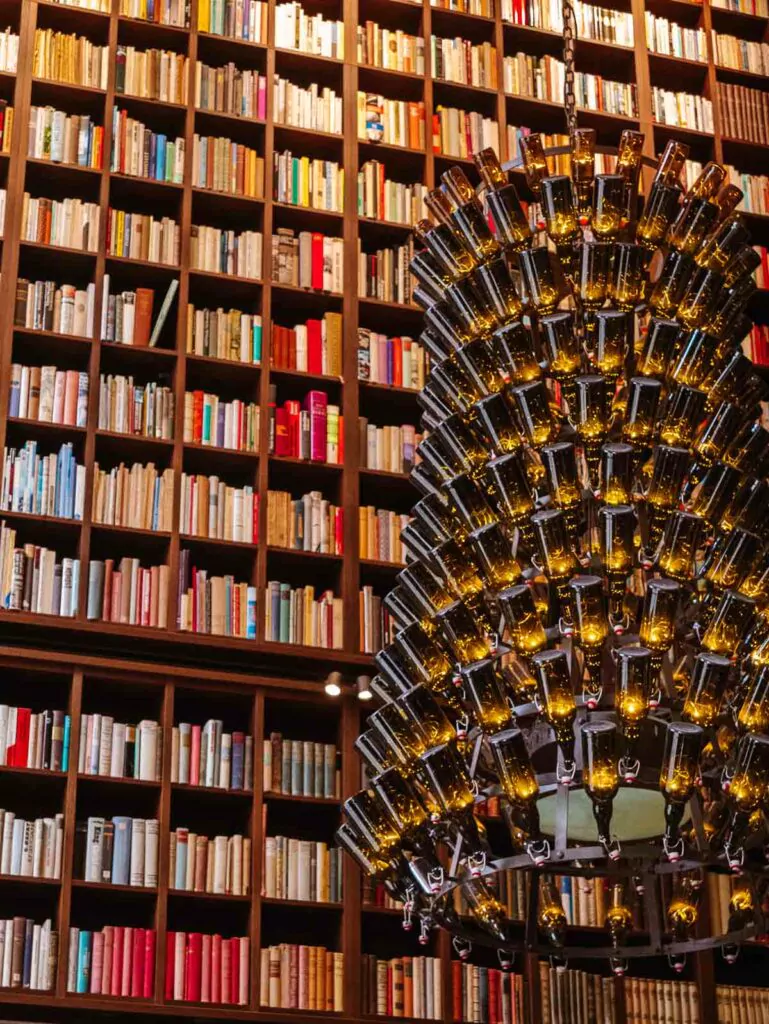
Why Innsbruck
Welcome to Austria! Innsbruck’s Christmas markets date back to the 16th century, and these days you’ll find six Christmas markets in the city, ranging from traditional Old Town markets to independent arts and crafts markets to markets with a view.
Head to the Old Town for an epic Christmas tree and a light show projected onto the beautiful buildings that border the square, and be there at 5.30pm to hear live music from the historic Golden Roof which looks down onto the market stalls. For a stunning view over the market and out to the mountains beyond you can head up the spiral staircase to the viewing platform of the city tower, tickets are €4.50 for adults.
After ticking off Old Town, wander down the cobblestone roads to get to Market Square, where you’ll find the world-famous Swarovski Christmas tree made from tens of thousands of dazzling crystals.
And for the markets with the best view, catch the cable car to the Hungerberg Markets perched on the slopes above Innsbruck. There are only a few small, independent stalls up here but it’s worth it to see the city’s Christmas lights from above.
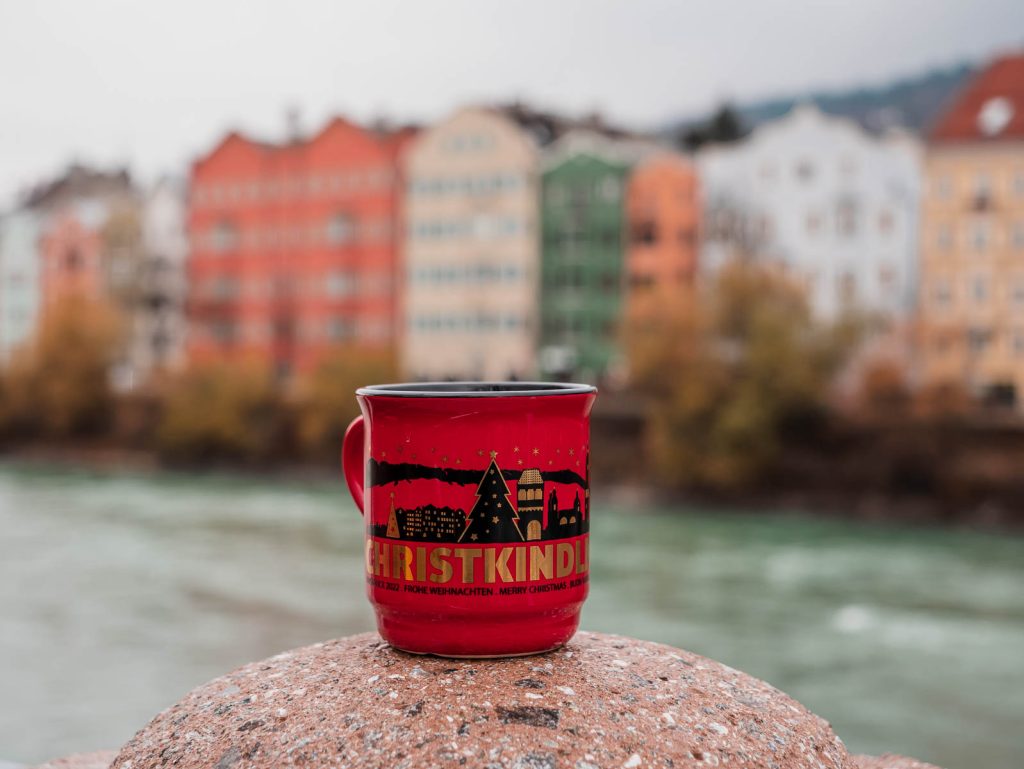
Other things to do in Innsbruck
- Visit the world-famous Swarovski Crystal Worlds, a 30 minute train from Innsbruck
- Learn about Prince Archduke Ferdinand II at Schloss Ambras
- Experience an authentic Tyrolean cultural night of music, dance and food
- Savour the incredible view from Nordkette, 2256m above sea level
Where to stay in Innsbruck
Budget | Montagu Hostel, MEININGER Innsbruck Zentrum and Pension Stoi
Mid-range | Hotel Neue Post, Hotel Mondschein, Nala Individuellhotel and Faktorei
Luxury | Hotel Maximilian, the PENZ Hotel, aDLERS Hotel Innsbruck and Altstadthotel Weißes Kreuz
Self-contained | Kaiser Max Design Apartments, Apartment Mischa, Quartier 99 and Prada Elf Apartment
Check rates and availability for your Innsbruck travel dates at booking.com➡️
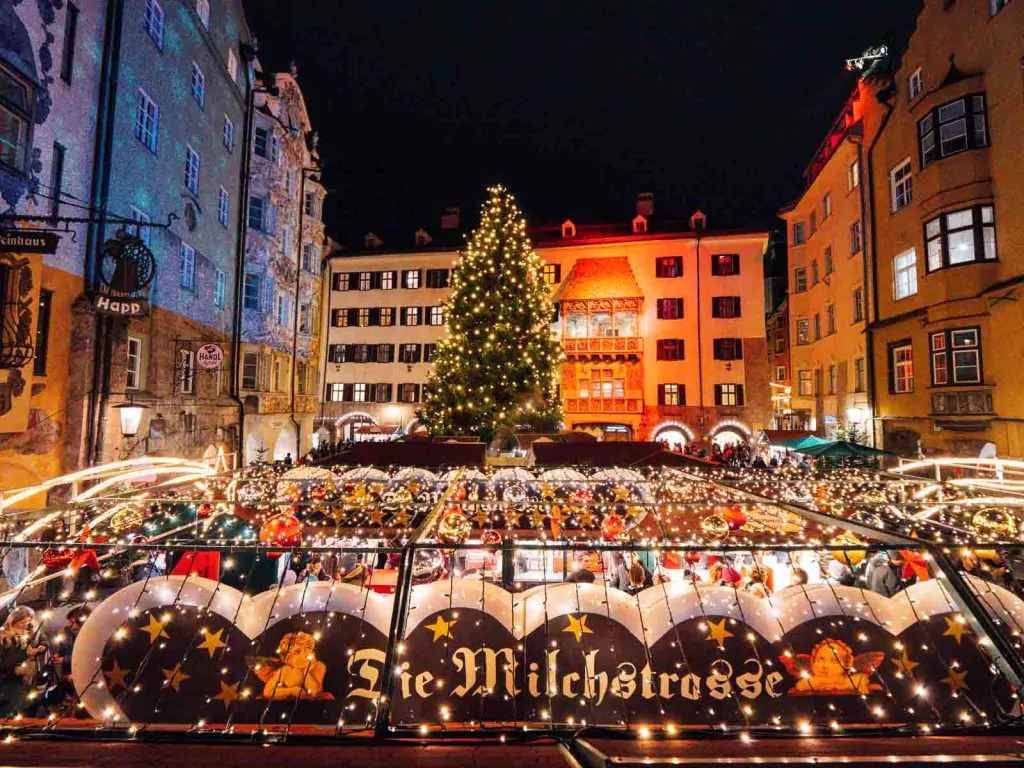
Day 11: Salzburg
Salzburg Christmas market dates for 2025: 20 November 2025 – 1 January 2026 (official website here)
How to get from Innsbruck to Salzburg
Direct trains run often and take about 1h 50m, no seat reservation required for rail pass holders.
About Salzburg
The hills are alive with the sound of music, and Salzburg is alive with the sound of Christmas!
Salzburg’s main Christmas market is one of the most festive sights I’ve ever seen, with strings of lights draped above the market like stars in the sky, an endless selection of Christmassy treats to try, and handcrafted decorations and souvenirs to purchase. Add in Baroque architecture of the UNESCO-listed Old Town, an ice skating rink, and a medieval fortress up on the hill behind it, and the Christkindlmarkt is one for your Europe winter bucket list.
There are a number of other markets too, including the local favourite at Mirabellplatz, a family-focused market at Schloss Hellbrunn, Stern Market with unique food products and gifts, and a diverse range of stalls at Salzburg Fortress (Hohensalzburg). I’d recommend catching the funicular to the top and then walking down to the Domplatz market.
TRAVEL TIP: Keep an eye out for the creepy Krampus Run, an event typically held on Krampusnacht (5th December) in Austria and Germany, although the frightening tradition seems to be invading other countries too! Krampus is basically evil Santa Claus, a half-goat, half-demon that punishes misbehaving children at Christmas.
The Krampus Run is when people dress up as Krampus and parade through the city scaring, chasing and hitting spectators with bunches of sticks. Hilarious, yet somewhat terrifying, to witness and be a part of.
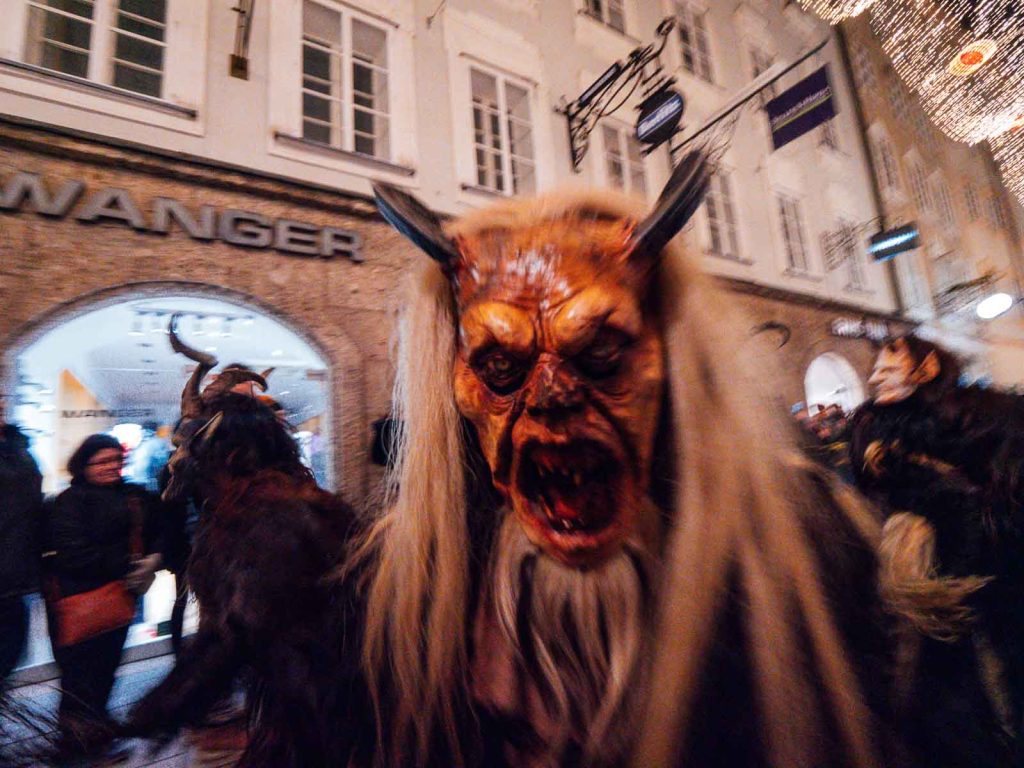
Other things to do in Salzburg
- Experience the city through Maria’s eyes with a Sound of Music tour
- Take a cheap guided tour around the Cathedral
- Enjoy a Mozart concert at Mirabell Palace
Where to stay in Salzburg
Budget | I stayed at MEININGER Salzburg, a hotel/hostel hybrid with dorm rooms, private rooms, guest kitchen, laundry facilities, hotel bar and bikes for rent. Slightly out of the city but right next to a bus stop, a great budget option. Other budget-friendly options are YoHo Youth Hostel, Stadtalm Naturfreundehaus and The Keep Eco Rooms.
Mid-range | Gästehaus im Priesterseminar Salzburg, Hotel Max 70, B&B Villa Verde and Boutiquehotel am Dom
Luxury | Hotel Bristol, Goldgasse, Hotel Goldener Hirsch and Hotel Sacher Salzburg
Self-contained | Villa Leopoldskron, Villa Maxglen, Mozart’s Garden Villa and Villa Salzburg
Check rates and availability for your Salzburg travel dates at booking.com ➡️

Day 12-13: Vienna
Vienna Christmas market dates for 2025: 14 November – 26 December for most markets, but Schönbrunn opens 7 November and Karlsplatz opens 21 November (official website here)
How to get from Salzburg to Vienna
Direct trains run often and take 2h 25m, no need for a seat reservation.
About Vienna
One of Europe’s cultural hubs, Vienna’s magic absolutely peaks at Christmas, when it’s all lit up by light displays, art installations and buzzing markets throughout the city.
You’ll definitely need two days to explore Vienna’s markets because they’re quite far apart, unlike many smaller cities on this list. If you have longer than 2.5 weeks to complete this European Christmas market itinerary then consider adding a third day on in Vienna.
The main Christmas market takes place at Rathausplatz, where you’ll be greeted by a bow-topped light arch. Go ice skating, be dazzled by the impressive Christmas decoration stalls, or head into the neighbouring park to see giant light displays.
Other markets to put on your list are Christmas Village Belvedere which is set in front of the stunning Baroque palace, Spittelberg market for more independent and authentic products, Maria Theresien Square for a smaller version of Rathaus, and the more modern MuseumsQuartier which has artistic light projections, bars, live music and street food.
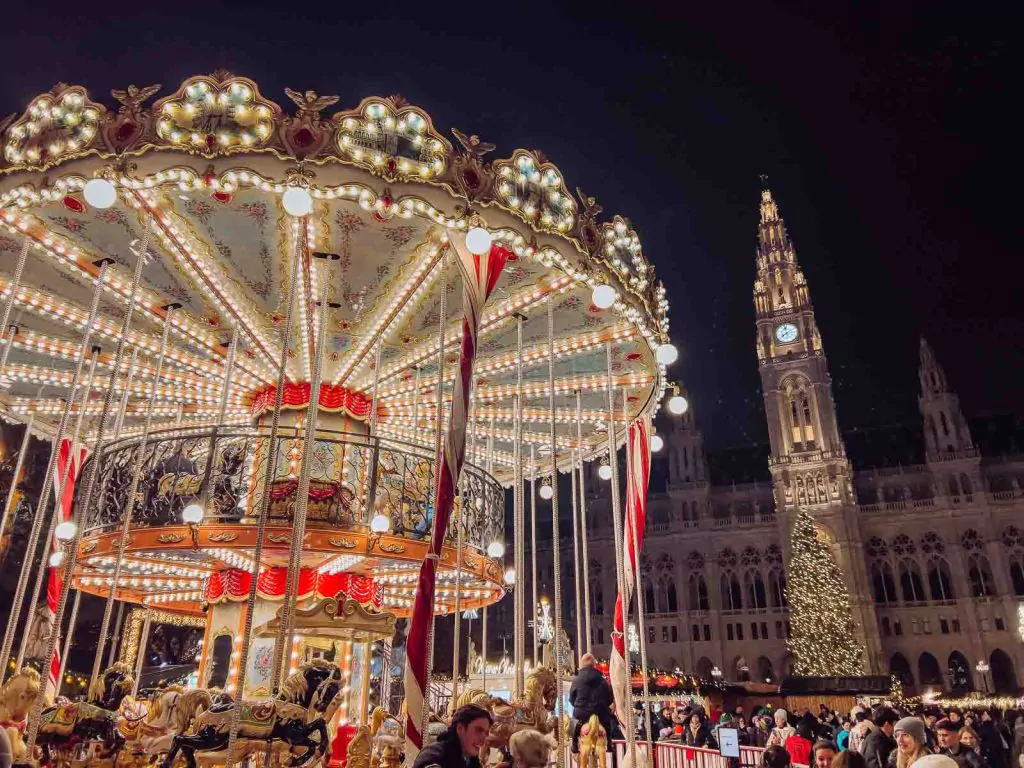
Other things to do in Vienna
Aside from the markets there are plenty of things to do in Vienna, from museums and galleries to coffee houses to opulent palaces.
- Do a top-rated food tour around coffee houses and the Naschmarket
- See a different side of the city with a Historical Crimes walking tour
- Go up to the rooftop observation deck of St. Stephen’s Cathedral for sunset
- Visit the exquisite Schönbrunn Palace & Gardens
Where to stay in Vienna
Budget | My absolute top pick for Vienna budget accommodation is JO&JOE Vienna, a funky hostel with loads of facilities, including kitchen facilities, an onsite diner, work-friendly areas, plenty of fun events, a rooftop terrace, comfy dorm rooms and spacious private rooms.
Mid-range | Boutiquehotel Das Tyrol, Rioca Vienna Posto 2, Superbude Prater and ARTIST Boutique Hotel
Luxury | Rosewood Vienna, The Leo Grand, Hotel Sans Souci and Hotel Sacher
Self-contained | Karl und Anton Boutique Apartments, Oliver Apartments and URBM Rise
Check rates and availability for your Vienna travel dates at booking.com ➡️
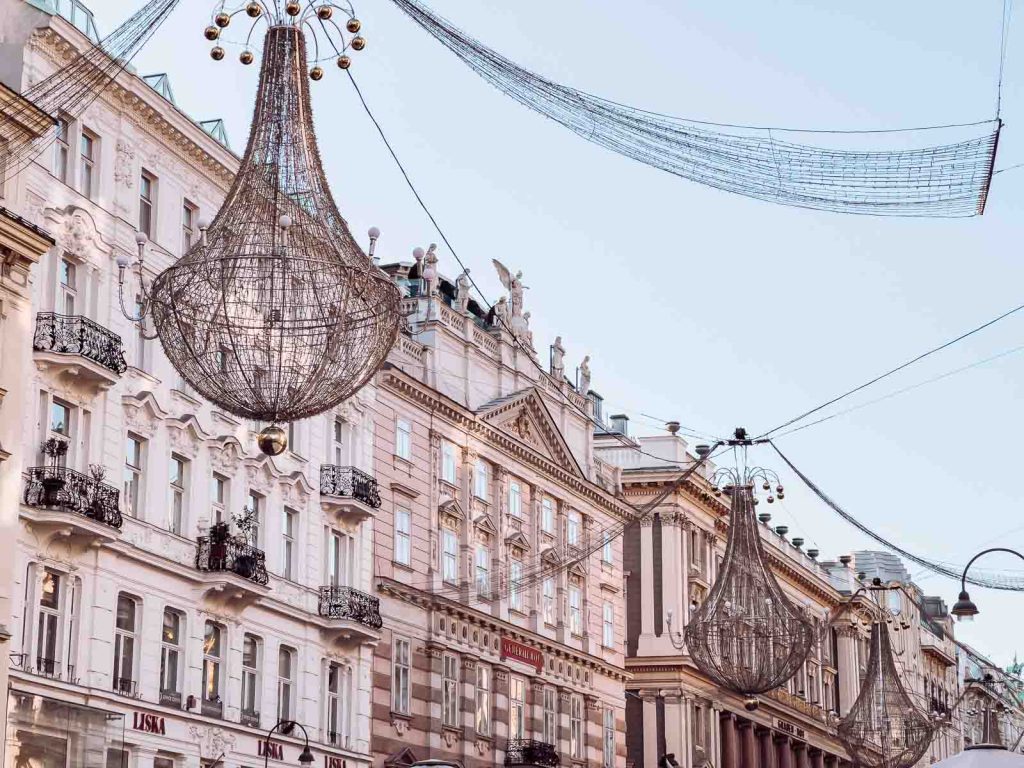
Day 14: Bratislava day trip from Vienna
Bratislava Christmas market dates for 2025: 21 November – 31 December (official website here)
How to get from Vienna to Bratislava
You can catch a bus with RegioJet or FlixBus for as low as €4, they take between 40m and 1h 20m.
About Bratislava
Offering a different experience to the markets of Germany, France and Austria, Slovakia’s capital is well worth a visit for a unique and affordable addition to this Europe Christmas market train itinerary.
There are a few different markets to explore, all easily reached by walking, and your money will go further here so consider using Bratislava for present shopping. Don’t skimp on the food either, be sure to try ciganska (a bun with a tasty pork cutlet or chicken fillet), lokse (fried potato dough topped with sweet or savoury stuff) and medovina (honey mead).
Other things to do in Bratislava
- Have a cheap wine tasting session with a local sommelier
- Explore Bratislava Castle on the hill above the city
- Find the Blue Church, it looks like it’s from the Smurfs!
- Spot all the interesting statues dotted around the city
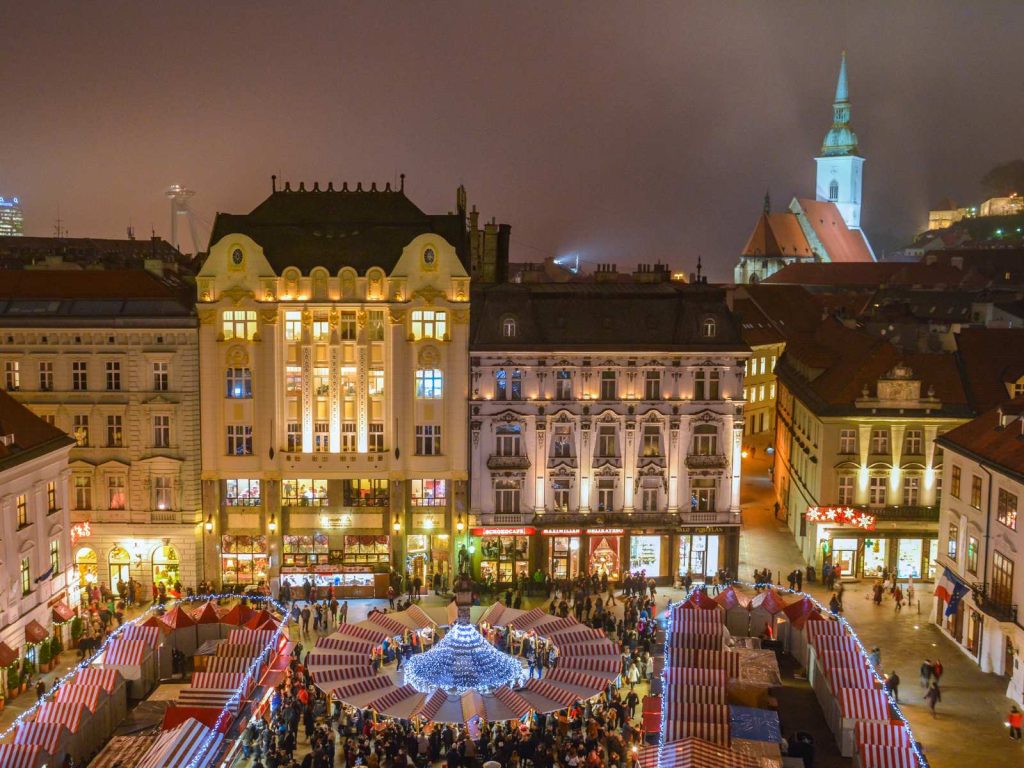
Day 15-16: Prague
Prague Christmas market dates for 2025: 29 November – 6 January (official website here)
How to get from Vienna to Prague
The longest journey on this itinerary, Vienna to Prague direct trains run every two hours or so and they take 4h 25m. Most trains don’t require seat reservations for rail pass holders.
About Prague
Budget travellers rejoice, Prague is a fantastic Christmas market option that’s genuinely easy on the wallet! Accommodation here is affordable year-round, market food is great value, and there’s a bunch of things to see and do that don’t require any money at all.
Prague’s Old Town Square is one of the most photogenic Christmas scenes in all of Europe, with a stunning wired angel lit up in front of the exquisitely-carved Gothic Church of Our Lady before Týn. Stalls here sell traditional market treats as well as local cuisine like roast pork on a spit, grilled sausages and trdelník (chimney cakes). You can also find a big stage here that has a busy events programme of music and dance performances.
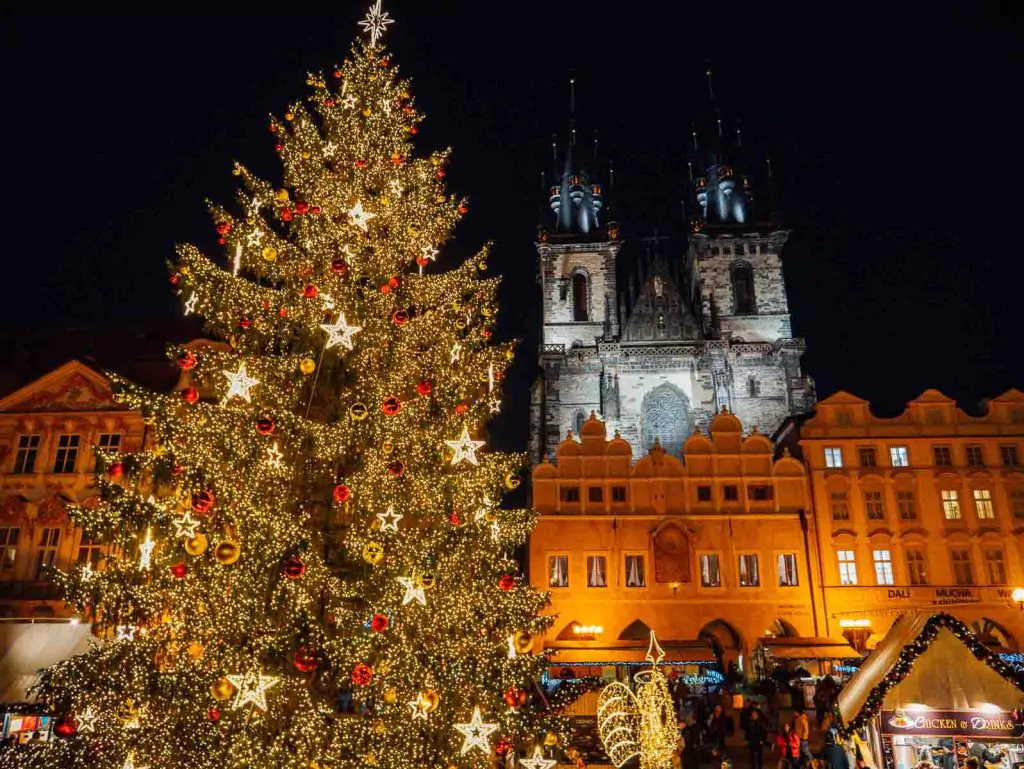
Just a short walk from Old Town Square you can head to Wenceslas Square, which hosts stalls mostly selling handmade arts and crafts.
And no Christmas visit to Prague would be complete without heading up to Prague Castle, the courtyards turn into a winter wonderland with local artisans selling trinkets and artwork, hearty dishes being served up and plenty of epic photo opportunities. From the castle you can walk back to Old Town Square, crossing over the iconic Charles Bridge.
Other things to do in Prague
- See the Astronomical Clock’s mechanical procession of the 12 Apostles, it happens on the hour between 9am and 9pm
- Climb the Old Town Hall tower for the best view of the square
- Do a day trip to the infamous Bone Church, a.k.a. the Sedlec Ossuary
- Experience the legendary Prague nightlife with a pub crawl
- Take a guided tour around Prague Castle
Where to stay in Prague
Budget | I recently stayed at Brix Hostel which is great if you’re looking for a social hostel, but not ideal if you need peace and quiet. Other well-rated budget accommodation options are Hostel Little Quarter, Sophie’s Hostel, Giotto Apartments, Hostel One Miru and Prague Dream Hostel.
Mid-range | Revelton Studios Prague, Hotel Residence Agnes, Hotel CUBE Prague, Allure Hotel Prague and Unitas Hotel
Luxury | The Julius, Four Seasons, The Grand Mark, Alchymist Grand Hotel and Hotel Republika
Self-contained | Mooo by the Castle, Hotel Diana and Malostranska Residence have options with kitchens/kitchenettes
Check rates and availability for your Prague travel dates at booking.com ➡️

Day 17-18: Dresden
Dresden Christmas market dates for 2025: 26 November – 24 December (official website here)
How to get from Prague to Dresden
Direct trains run every couple of hours and take 2h 27m in total, no seat reservations required for rail pass holders.
About Dresden
It would be illegal to write a Christmas market itinerary for Europe and not include the oldest Christmas market, so we’re going to wrap up this trip by heading back into Germany.
Dresden’s main market is Striezelmarkt, which has been hosting Christmas revellers since way back in 1434. These days the visitor numbers reach more than 2.5 million people each year! Typically the Striezelmarkt showcased German sweet treats, including striezel (also known as stollen), a spiced bread filled with candied fruits and doused with icing sugar. Eating striezel at the Striezelmarkt is a must-do for any Europe Christmas market itinerary!
There are many other Christmas festivities to experience too, from traditional craft markets to light displays to alpine huts and curling rinks.
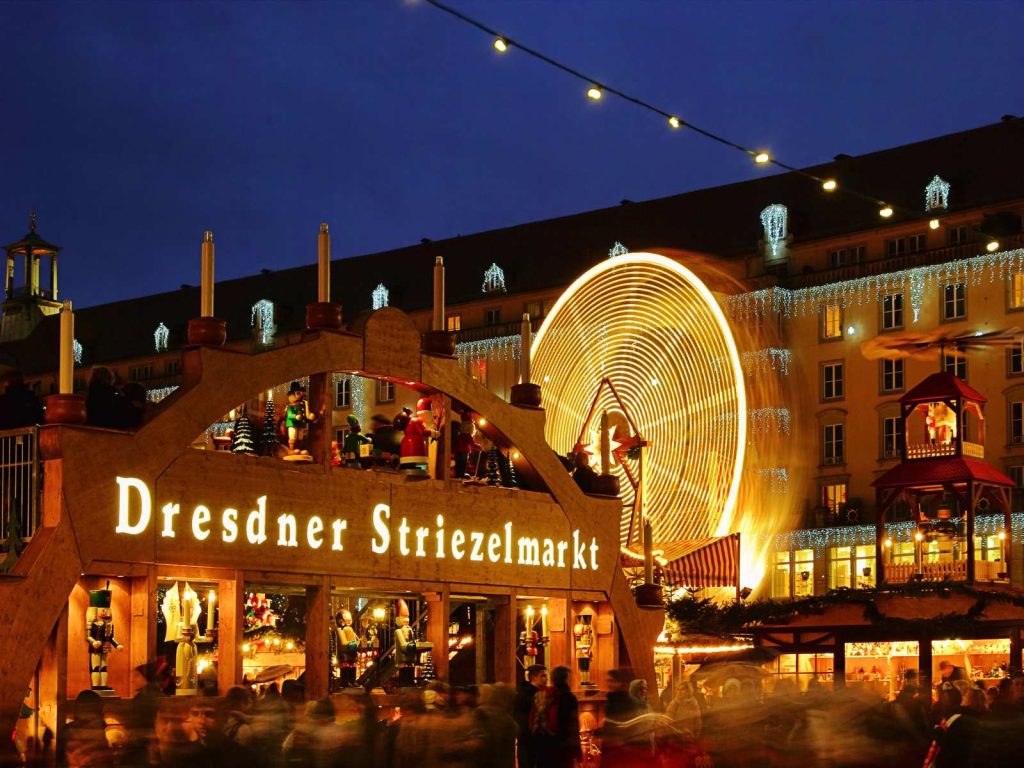
Other things to do in Dresden
- See the city with this top-rated Trabi tour
- Do some wine tasting on a boat cruise
- Visit the beautiful Pillnitz Castle
- Take a spooky Night Watchman evening tour through the Old Town
Where to stay in Dresden
Budget | MEININGER Dresden Zentrum, Pension Dresdener Panorama, B&B Trobisch and Gastezimmer Richter
Mid-range | mightyTwice Hotel, ARCOTEL HafenCity and Schloss Hotel Dresden Pillnitz
Luxury | Townhouse Dresden, Relais & Châteaux Bülow Palais and Felix Suiten am Zwinger
Check rates and availability for your Dresden travel dates at booking.com ➡️
Then to make the itinerary a loop and get from Dresden to Frankfurt it’s a direct 4h 25m train, no seat reservation required for rail pass holders. Too easy!
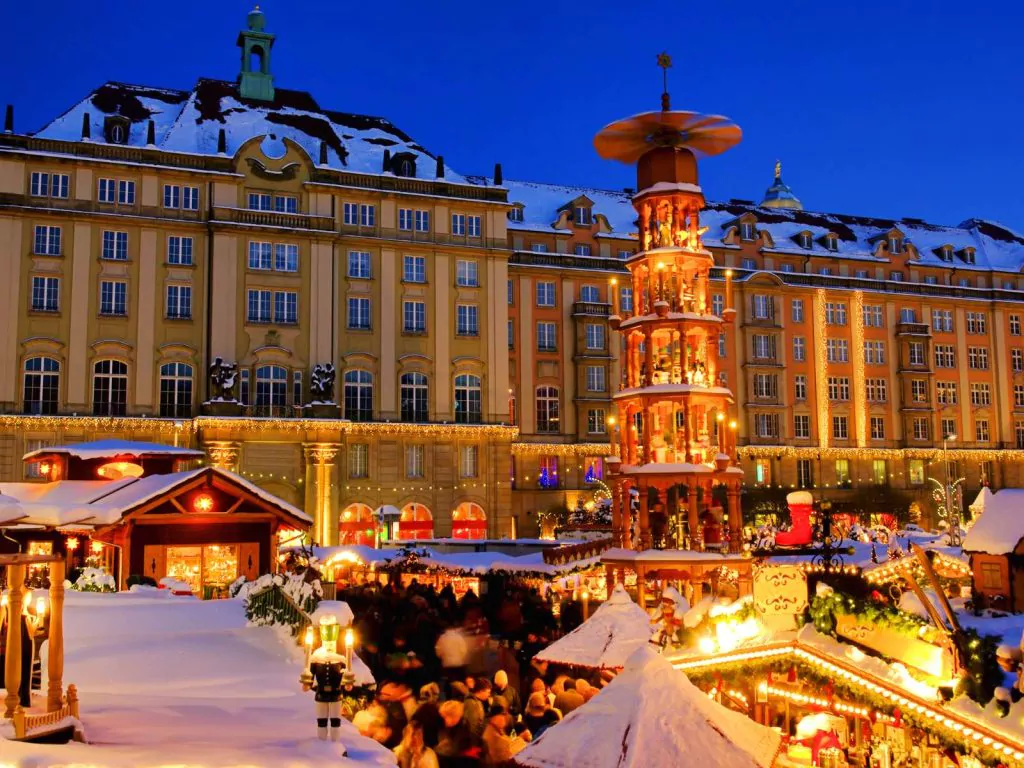
If you have less time
If you only have time for a one week Europe Christmas markets itinerary then you could do any of these legs of the trip:
- Frankfurt > Cologne day trip > Nuremberg day trip > Strasbourg > Colmar day trip
- Dresden > Frankfurt > Cologne & Nuremberg day trips
- Innsbruck > Salzburg > Vienna > Bratislava day trip
- Strasbourg > Basel > Innsbruck > Salzburg
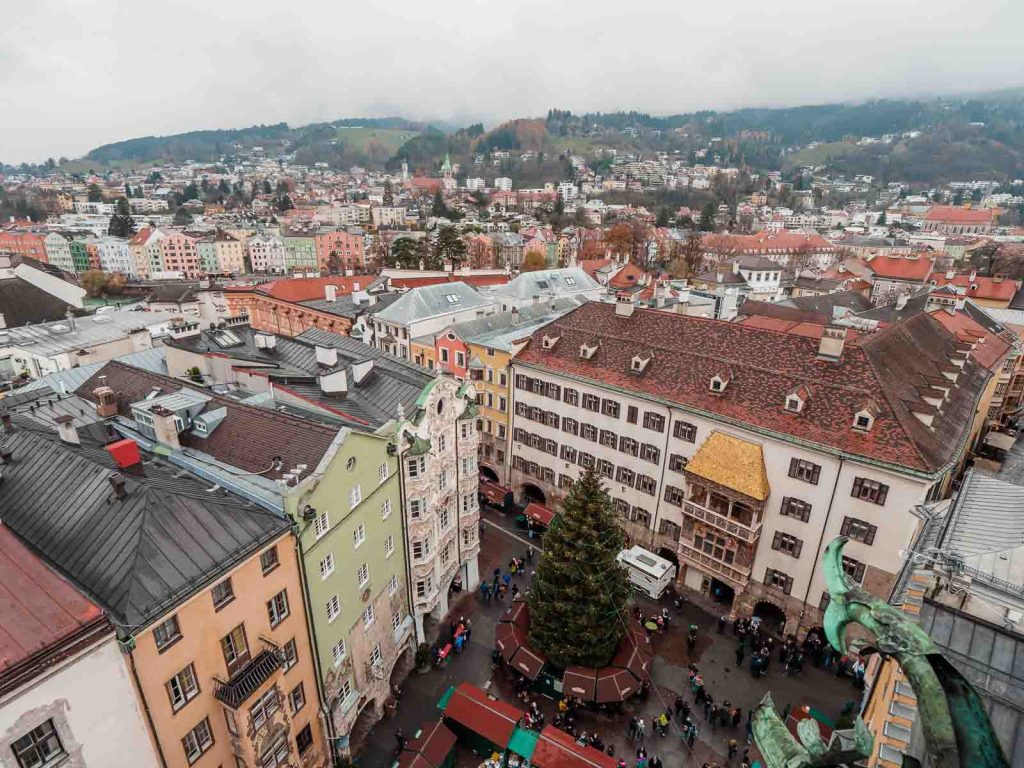
If you have more time
If you have more time to spend exploring the European Christmas markets by train then you could either take your time and add on extra days in places like Strasbourg, Vienna and Prague for general sightseeing, or instead you could add in overnight stops like these:
- Zurich between Basel and Innsbruck
- Bolzano in the Dolomites which hosts Italy’s best Christmas market (2h direct train from Innsbruck)
- Budapest between Vienna and Prague
- Other German cities like Berlin or Munich
- Add on a ski holiday, I love Ski Hostel in Switzerland for affordable ski packages
And if you have looooads of time, like a few months, use my comprehensive three month Eurail itinerary to build your ideal Europe route.
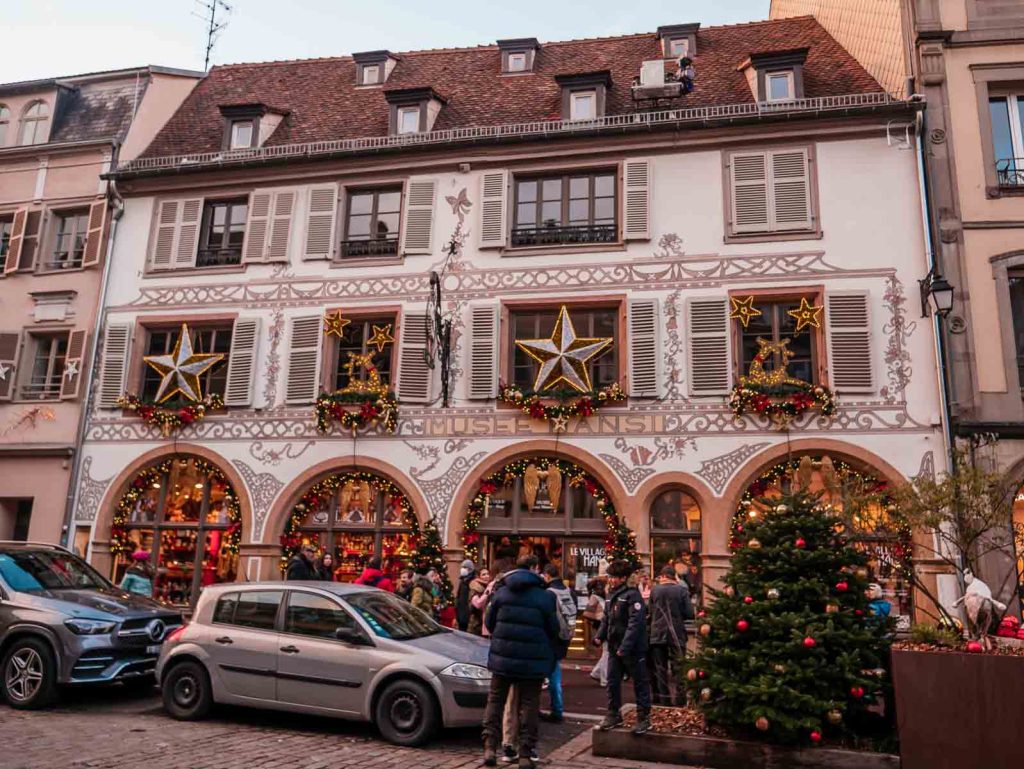
European Christmas market planning guide
What are Europe’s Christmas markets?
The famous Christmas markets in Europe are traditional street markets that run throughout the festive season in many European cities, selling Glühwein (mulled wine), Christmas decorations, holiday-themed souvenirs and loads of tasty seasonal treats.
While the history of European Christmas markets is disputed, with a number of markets claiming to be the ‘original Christmas market’, we know that they have been running in Germany since at least the 15th century, and in the following centuries the tradition caught on in Austria as well as German-speaking parts of France, Switzerland and Italy.
These days you’ll find some form of Christmas market in most major European cities, though not all are equal, as I discovered. More on that shortly!
Most European Christmas markets are free to enter and wander around, so you can enjoy the insane light installations, live music and Christmassy vibes without spending a cent. If you’ve got some spending money then you could grab a lumumba (hot chocolate with rum) or some bratwürst, rent some ice skates and try your luck on the rink, enjoy a carousel ride, or stock up on homemade gifts for friends and family back home.
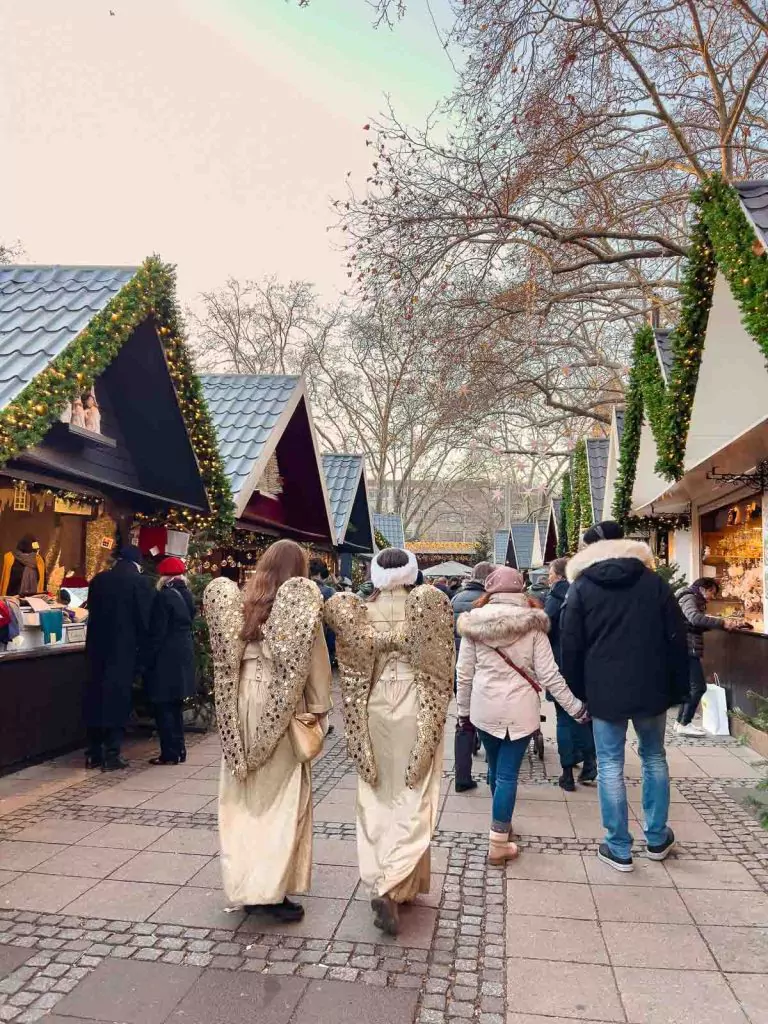
When do European Christmas markets start and end?
Each market has a different start date so you’ll need to research the official opening dates to figure this out, but most of the main markets in Europe open from mid to late November. Note that some smaller markets might have different dates to the main markets in the same city.
Some markets are open until early January, but some close right before Christmas.
In the itinerary above I’ve included all confirmed dates for 2025 as well as the official website with the announcements, so please double check the dates before you book anything.
On my first Christmas trip I made the mistake of planning my route based on the dates listed in a travel blog, before realising *after booking* that the Strasbourg markets didn’t start until the day after I left, all because I trusted a random website and didn’t fact-check. I managed to switch some things around luckily but it was very stressful and resulted in an extremely complicated itinerary where I doubled back multiple times. Rookie mistake on my part!
When is the best time to visit the Christmas markets?
If you’re able to, I would recommend visiting at the start of the market season, so around late November.
Local kids are still in school until mid-December so while you’ll still be contending with tourists, most local families won’t be out and about during the school day.
This all changes the week before Christmas, when things get absolutely hectic, accommodation prices ramp up to their maximum, and you’ll be waiting in long lines for your Glühwein.
What should you budget for this Christmas markets trip?
By far your biggest expense while exploring the Europe Christmas markets will be accommodation.
For small cities that focus heavily on Christmas tourism, like Strasbourg, Innsbruck, Colmar and Nuremberg, accommodation options are limited and prices absolutely skyrocket during the market season. If you plan on staying in these spots overnight then you need to book well in advance.
Here are some rough price examples for those places:
- Hostel dorm beds start from about €50-60 per night, with higher prices on weekends and closer to Christmas
- Centrally-located basic private rooms start from €80ish per night
- A mid-range hotel will set you back anywhere from €120-150
For bigger cities that have a more steady stream of tourists throughout the year, like Vienna, Prague and Cologne, there’s more accommodation available so prices might not be as ridiculous but you’ll still want to book in advance if you can.
Aside from accommodation and train tickets which we’ve already discussed, you’ll need to set aside for food, activities, public transport and trains.
Public transport costs will be minimal, most markets are close to the city centre and easy to get between on foot.
Activities will totally depend on your travel preferences and priorities, all markets in this itinerary are free to enter but there are some extra experiences you might want to add, like palace visits, light festivals, ice skating or sightseeing tours.
Food will also really depend on the city and on how much market food you want to eat, with prices ranging from €3 bretzels to €10 tarte flambées to €20 heartier meals with meat and veges. I’d recommend stocking up on snacks from the supermarket so that you can eat throughout the day without having to pay market prices every time you want a bite to eat.
TRAVEL TIP: I always use booking.com to book rooms with free cancellation, this way I can lock in a good price in advance but still leaves the flexibility to change my plans. Booking direct with hotels may be a bit cheaper (often it’s not!) but their cancellation policies often aren’t as good.
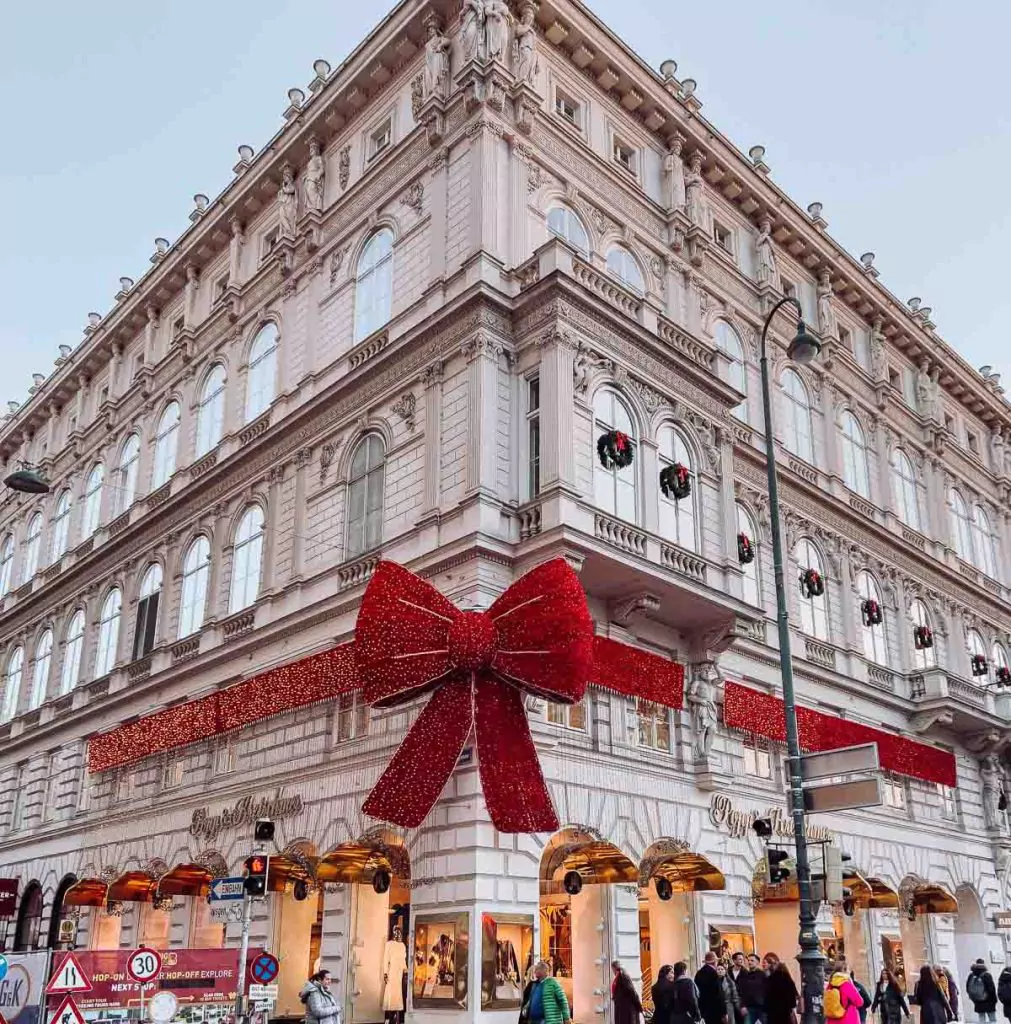
Travel essentials for your Christmas market trip
The best eSIM for Europe (and it’s not Airalo!)
You’ve probably heard all the buzz about eSIMs and how much money they save, but the eSIM brands with the biggest marketing budgets are (unsurprisingly) the most expensive. eSIMs from Airalo, Holafly, Saily, Maya, are all a waste of your precious travel money!
Luckily for you, I’m an over-analyser who can’t make a purchase decision without weighing up every single option, and I’ve found the best value travel eSIMs.
I use MobiMatter for pretty much every eSIM I buy, they have eSIM offers from local providers (rather than having their own branded eSIMs) and they’re usually 30-40% cheaper than the major eSIM providers. You can also get extra cashback with your first purchase if you use the promocode FINDINGALEXX (this gives me nothing by the way, just the happiness from knowing you’ve saved money!).

Sometimes you can find local eSIMs at the airport phone stalls for a bit cheaper, but if you want to set it up before you go and easily top up on the road, MobiMatter is almost always the best choice. The only places I’ve used a local eSIM in the past two years have been Morocco and the Maldives, because local carriers have much cheaper deals than any online options. For 30+ other countries, I’ve found that MobiMatter wins!
eSIM prices can change often so I’d recommend double checking your options before you go to make sure you’re getting the best deal, but here’s a snapshot of the current Europe eSIM deals from the big brands vs. MobiMatter for a 10GB, 30 day SIM, all in USD:
- MobiMatter: 10GB for $11.99
- Jetpac: 10GB for $14
- Maya: 10GB for $17
- Nomad: 10GB for $22
- Saily: 10GB for $35.99
- Airalo: 10GB for $37
- aloSIM: 10GB for $37
And if you need loads of data, here are some high-data or unlimited options:
- MobiMatter: 50GB over 30 days, $43.99
- Maya: 10 days unlimited for $29
- Holafly: 10 days unlimited for $36.90
- Saily: 100GB for $180
- Airalo: 100GB for $185
- aloSIM: 100GB for $185
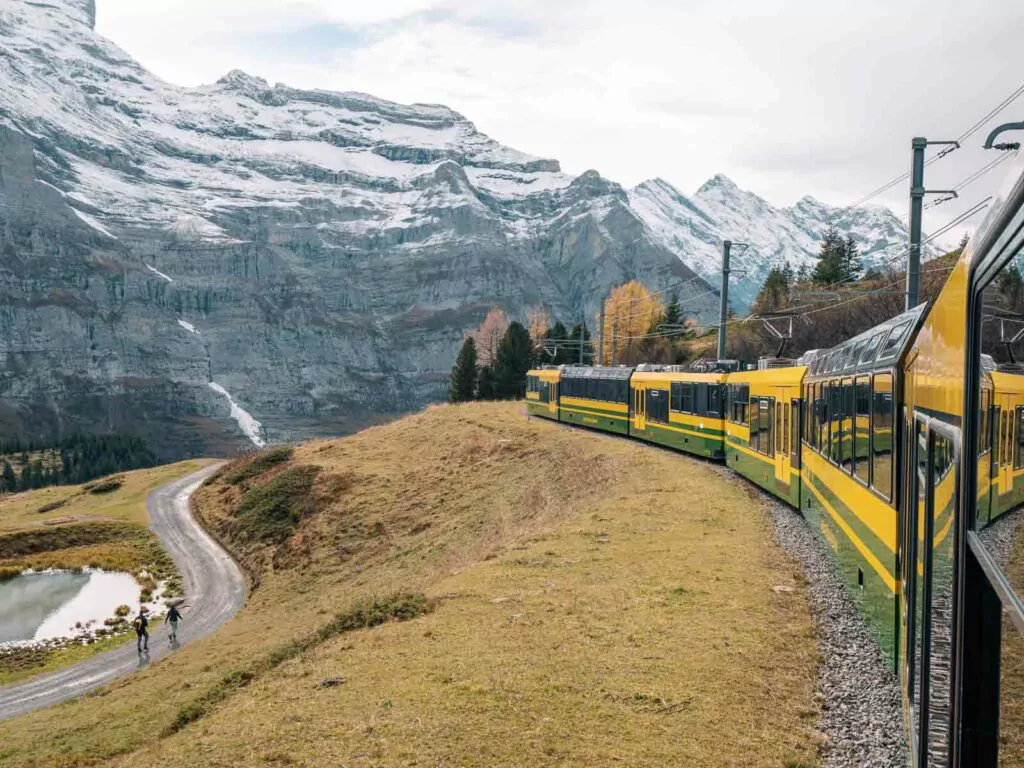
Full disclosure: I have had a paid partnership with MobiMatter in the past but that was after using them religiously for a year, I’d never accept payment to promote anything I don’t genuinely recommend. I have no ongoing partnership with them now except for affiliate links, which every creator can get from any eSIM company, and as I mentioned my promocode doesn’t give me anything, it just saves you a bit extra.
The best travel card for Europe
I’m a Wise girl through and through, I’ve been using Wise as my main travel debit card since I first started travelling full-time in 2019. The app is so easy to use, the fees are very low and transparent, and they use a MUCH better exchange rate than any bank.
Your card options do vary based on where you live though, if you’re from the US you have access to some incredibly good value travel credit cards which are going to offer better benefits while you’re on the road, but the rest of the world’s credit card options are nowhere near as good.
I also have an Amex which I use for big purchases to get points, but the fees/exchange rate/user-unfriendliness make it a terrible option for my daily spending.
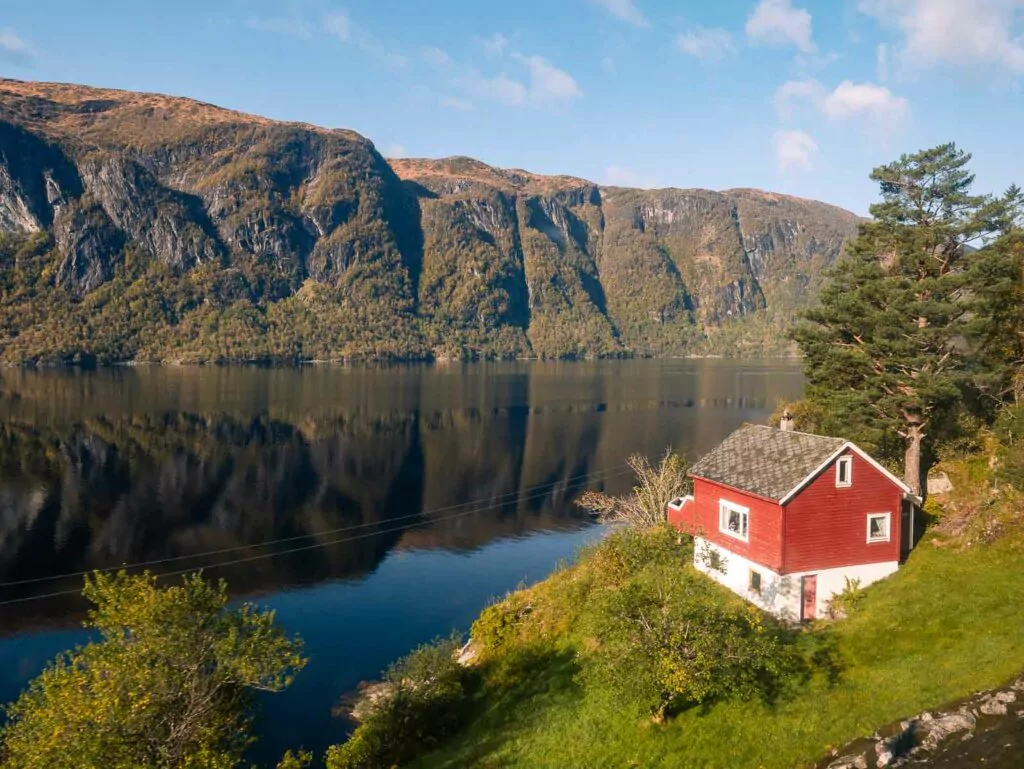
The best rail pass for Europe
If you’re doing this Europe Christmas market trip by train like I’ve suggested, a Eurail Pass or Interrail Pass might save you money. Scroll back up to the Eurail section before the itinerary for more info.
ALSO book your Eurail pass through Klook to get free cancellation, it’s the exact same price and if you buy direct they charge a 10% cancellation fee!

Save €€€ on activities and attractions in Europe
I’ve got two promocodes that can save you a decent chunk of money on your Europe adventures if you’re booking any tours, transfers or attractions.
- Save 10% on your first booking on Klook with the promocode FINDINGALEXXKLOOK
- Save 10% on your first booking on KKDay with the promocode FINDINGALEXX
- Save €100 on any tours over €1250 on TourRadar if you choose to book a group trip instead, use promocode ALEXX100
The Klook and KKDay codes work for multiple activities in one booking, so if you’re planning a bunch of things then it’s best to book them all together as you can only use the code once per account. Or just set up a new account 👀
It’s best to check direct websites to compare things like price and cancellation policy, but I’ve found that Klook especially is usually the same price or sometimes slightly cheaper, and the code gives you extra!
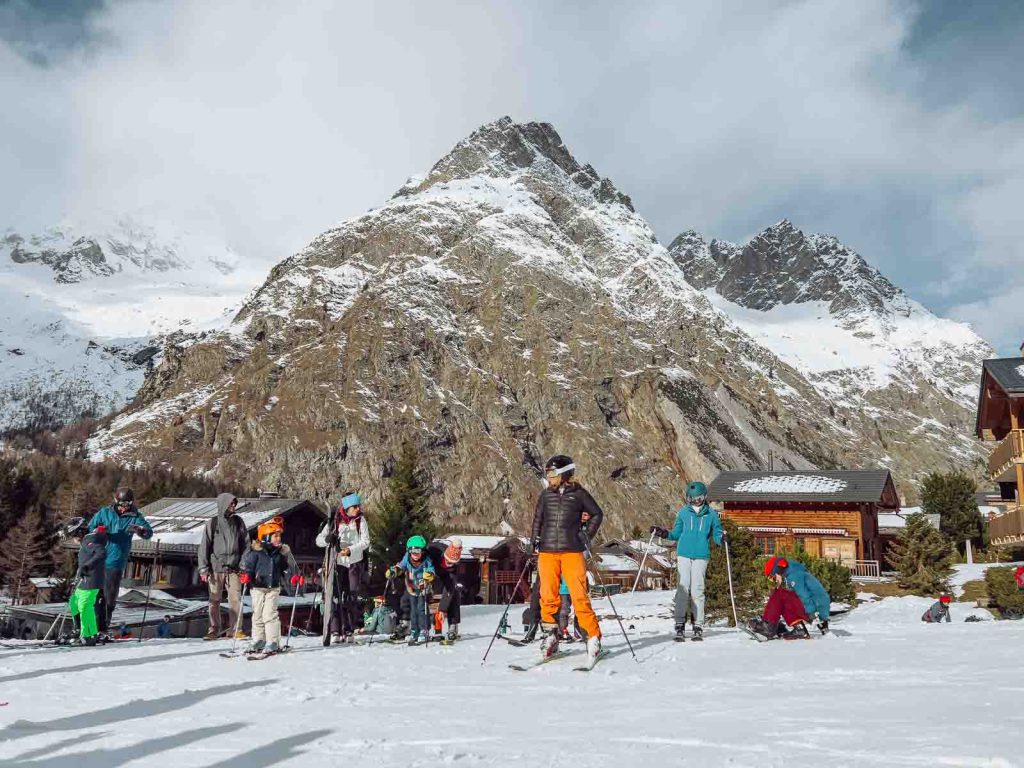
Why travel Europe’s Christmas market by train?
Europe’s rail network is incredible well-connected, particularly in the countries that host the best Christmas markets, like Germany, Austria and France, so catching a train between Christmas markets is an affordable, time-efficient, stress-free way to get from A to B.
It’s cost-effective
While low cost carriers in Europe do offer very competitive airfares between hub cities, flying comes with additional costs like booking checked luggage, selecting seats, getting to and from the airport, and buying airport/plane food when you’re hungry. If you’re travelling with carry on only you might be able to avoid that first one, but in Europe winter chances are you’ll want big jackets, scarves and chunky boots, so it’s a bit harder to stick to the 7kg weight limit in the cooler months.
If you’re catching a train you can take luggage without paying any additional fee, there’s always easy and cheap public transport to get to the station, and you can take however much food and drink you want from the supermarket without worrying about weight or getting your water bottles through security.
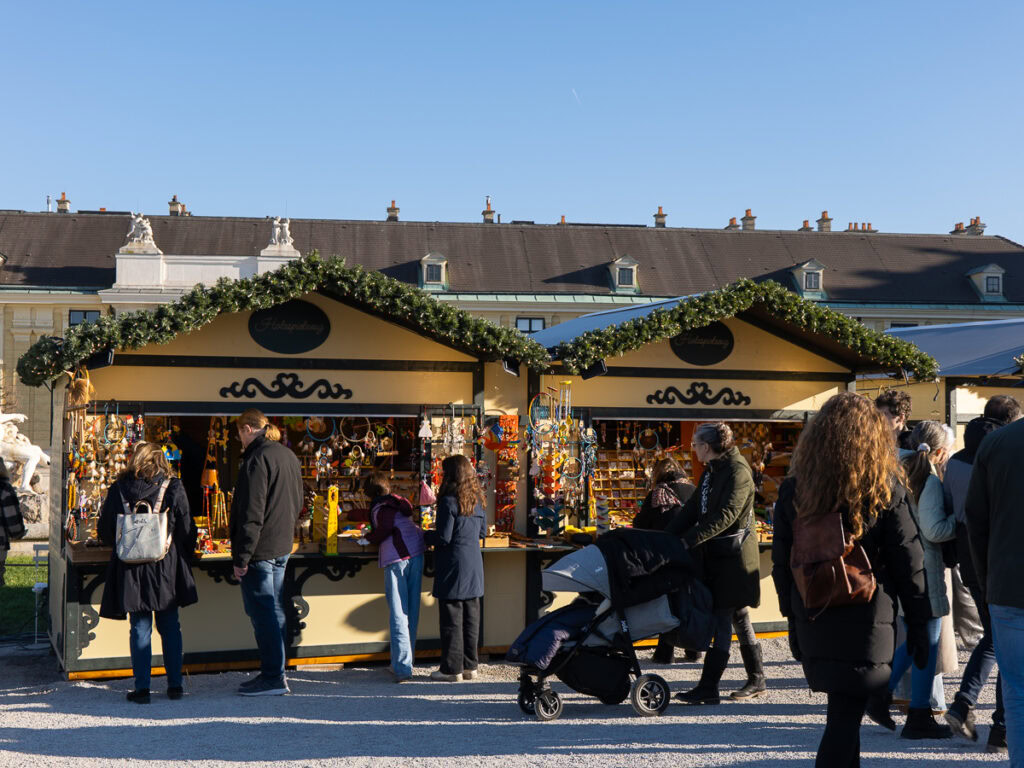
It’s fairly quick
Thanks to a brilliantly connected network of trains and being able to avoid annoying airport lines, your door-to-door journey is often shorter if you train rather than fly.
The journey itself might be longer but train stations are usually closer to the city centre and tourist areas than airports, and you only need to arrive 20 minutes before your train leaves to be able to find your platform and carriage, rather than the requirement of two hours for an international flight.
Most of the trains in this Europe Christmas market train itinerary are only a few hours, with only a couple sitting at the 4.5-5 hour mark.

It’s not as stressful as flying
Airports during the festive season are pure chaos, and while train stations aren’t exactly a meditation room either, they’re certainly easier to deal with.
Trains are typically less impacted by the weather so you’ll have less chance of cancellation, all of these routes below are serviced constantly throughout the day so you can easily switch to a later train if you miss a connection due to a delay, and the actual train journeys offer beautiful scenery and the chance to stretch your legs much easier than you can on a flight.
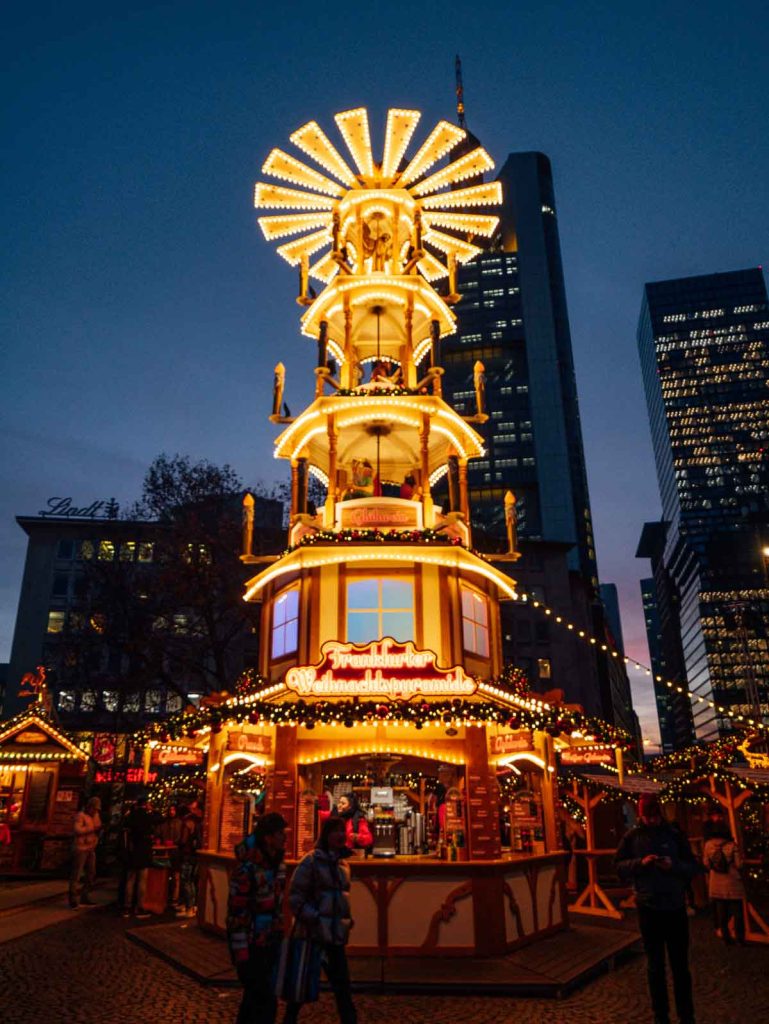
What are the best Christmas markets in Europe?
On my first dedicated European Christmas market trip I managed to visit a whopping 15 Christmas markets in nine countries in just two weeks. Yes, it was very hectic, I would not recommend going that fast!
Since then I’ve made two more Europe winter trips, and my total is now sitting at 40 markets in 20 cities in 13 countries. Not too bad for a southern hemisphere gal who hates being cold 🙃
Some of the markets were pure magic and exceeded all expectations, but some of the markets left me unsatisfied and ripped off. Here are my favourite Christmas markets that are absolutely worth a visit, along with a few that just didn’t quite impress me.
The best Christmas markets in Germany
I went to Cologne and Frankfurt which both have a number of huge markets that are easy to walk between. Cologne offers the quintessential German Christmas market experience, and Frankfurt was more of a representation of modern Germany, with street food stalls serving up cuisines from all over the globe.
Some other top-rated German cities for Christmas markets are Dresden (who claim to be the first Christmas market, dating back to 1434), Nuremberg and Rothenburg ob der Tauber.
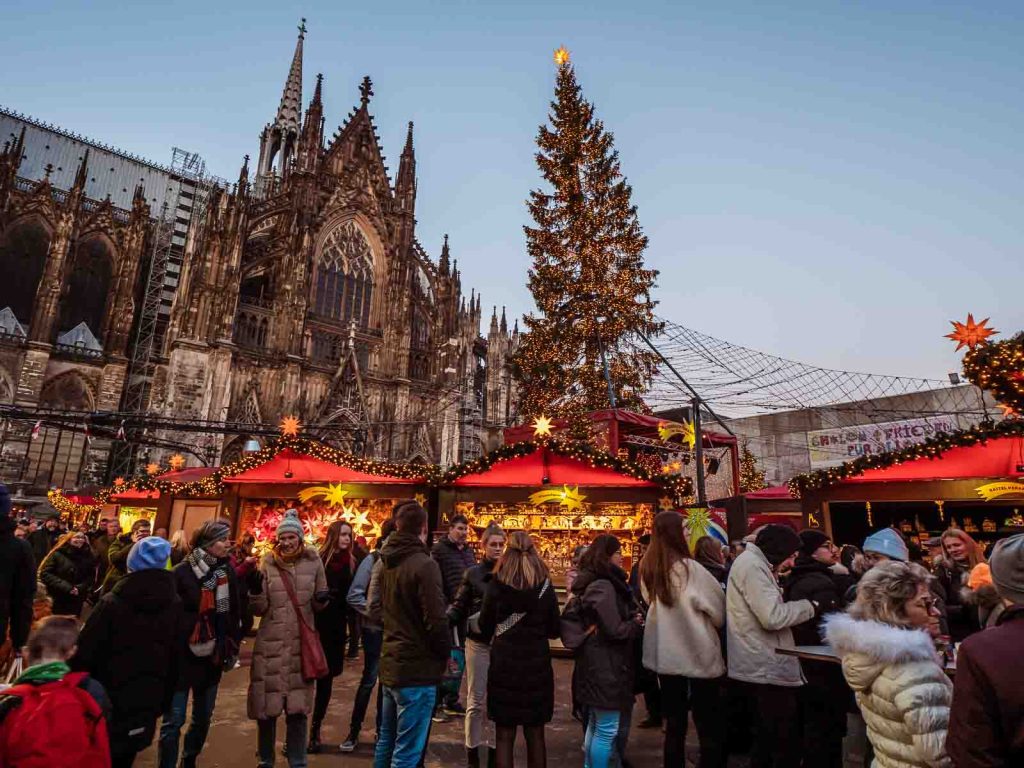
The best Christmas markets in Austria
Austria’s best Christmas markets are without a doubt in Vienna, Salzburg and Innsbruck. Vienna’s markets are spread over the city and range from regal to traditional to contemporary, and Salzburg and Innsbruck both boast classic Christmas market vibes in their colourful old towns.
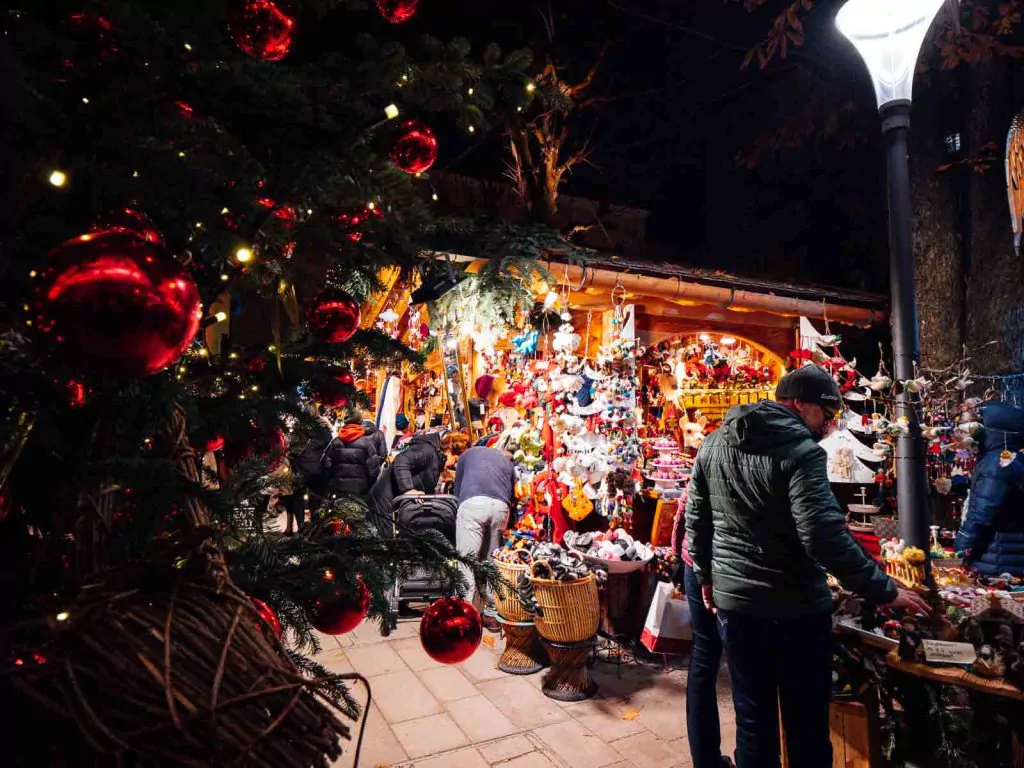
The best Christmas markets in France
With the tradition of Christmas markets leaking into France over the German border, it’s no surprise that France’s best markets are all located in the Alsace region, right on the eastern edge of the country.
Alsace’s biggest city is Strasbourg, which held France’s first ever Christmas market in 1570. These days Strasbourg claims the title “Strasbourg, Capital of Christmas”, and you’ll understand why once you experience the creative Christmas lights, hundreds of independent stalls and undeniable festive feeling.
Nearby Colmar is arguably even more beautiful with a more small-town vibe, or there’s Mulhouse (famous for textile souvenirs), Eguisheim (a very charming small market) or Riquewihr (this one has lots of local wines).
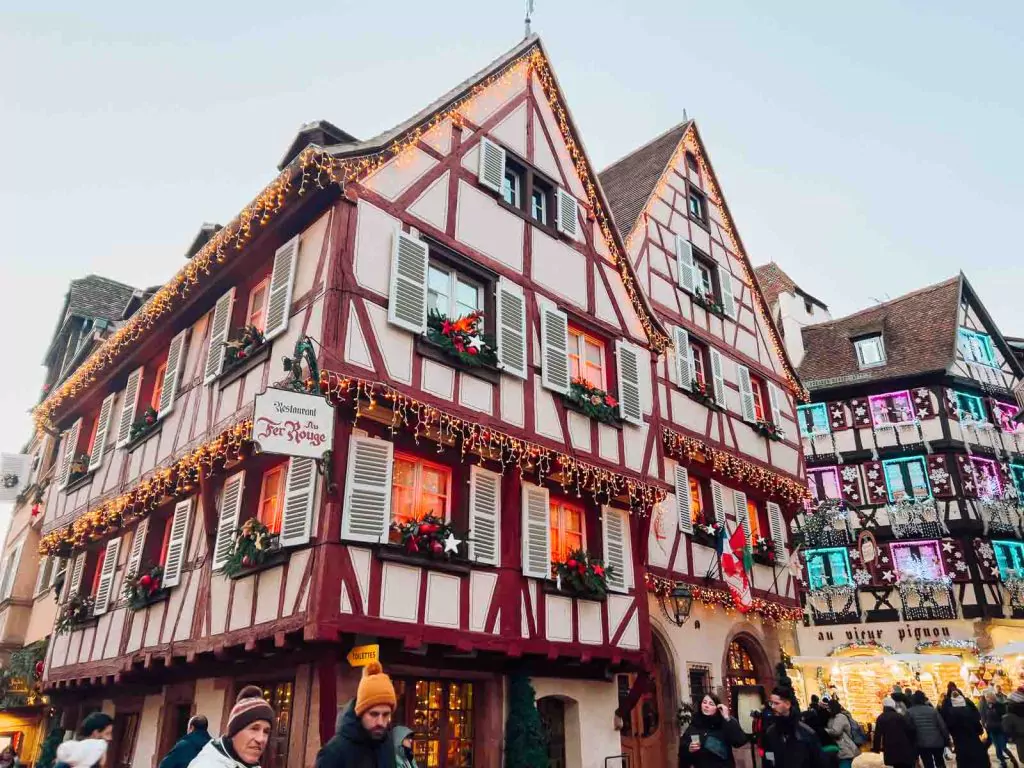
The best Christmas markets on a budget
My top pick for the best Christmas market in Europe on a budget is Prague, Czechia. You’ll be able to find affordable accommodation, food and drink is relatively cheap, and many of Prague’s must-sees like Charles Bridge and Prague Castle can be accessed for free.
I haven’t made it to Poland during the Christmas market season so I haven’t included any of its markets in this itinerary, but that would be another wallet-friendly option. Check out my 2 week Poland itinerary for an easy route that you can tack on after Prague or Dresden.
Many other blogs I read in while planning my Europe Christmas market route suggested Budapest as the best budget Christmas market in Europe, but based on my visit in 2022 this is no longer the case.
Post-COVID Hungary was hit with huuuge inflation, higher than most other countries in Europe, which pushed up stall prices for things like mulled wine, langos and kürtőskalács (chimney cake) to just as expensive, if not more expensive, than places like Frankfurt and Berlin. Accommodation in Budapest is still affordable but the food prices were something I absolutely had not budgeted for!
I didn’t make it to Budapest in 2023 or 2024 unfortunately so I can’t comment on the exact situation for the upcoming 2025 Christmas markets, but it’s just something to be aware of in case you’re seeing Budapest being recommended in older blog posts!

Other noteworthy Christmas markets in Europe
Other markets to add to your European Christmas market itinerary are London’s iconic Winter Wonderland, Copenhagen’s Tivoli Gardens markets, and the picture-perfect markets in Basel, Switzerland.
Christmas markets I didn’t rate
Some of the Christmas markets I wasn’t impressed by:
- Amsterdam, Netherlands: Looked festive at first glance but they were pretty average, felt super commercial!
- Florence, Italy: The German-style market in Piazza Santa Croce gets a 10/10 for effort, but Christmas markets are not a cultural tradition in Italy and it shows
- Oslo, Norway: Expensive (obviously, it’s Oslo) and not worth planning a whole trip for
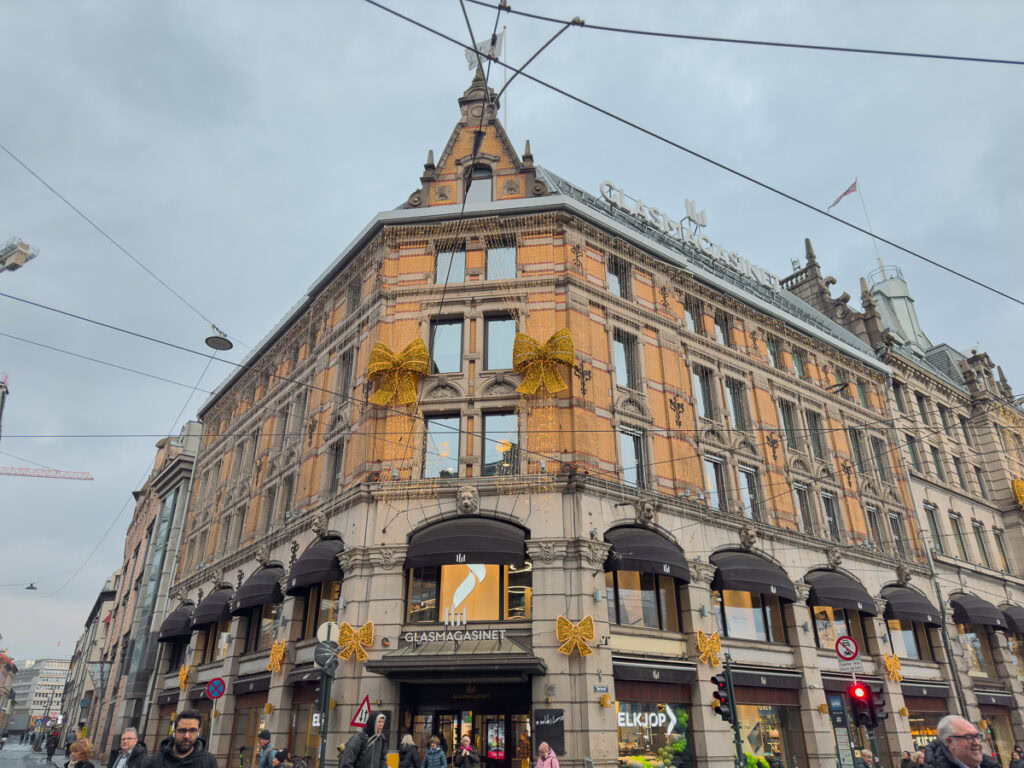
Europe Christmas markets FAQs
Are European Christmas markets worth visiting?
Yes, Europe’s Christmas markets are absolutely worth visiting, especially if you love festive charm, beautiful light displays and hearty winter cuisine! The traditional markets in places like Germany, Austria and France are a unique cultural experience you won’t find anywhere else in the world.
Which European country has the best Christmas markets?
Germany consistently comes out on top as the best Christmas market country in Europe, with some markets that have been running for almost 600 years 🤯 Places like Rothenburg ob der Tauber, Nuremberg and Cologne are absolute magic, but all markets I’ve been to in Germany impressed me.
Austria, France (particularly the Alsace region) and Switzerland are also incredible.
Where is the most Christmassy place in Europe?
Strasbourg in France proudly takes the title ‘Capital of Christmas’, and the city goes allllll out with lighting, art installations and markets dotted all around the city. Other ultra-Christmassy places include Colmar nearby, Innsbruck in Vienna and Nuremberg in Germany.
How long do the Christmas markets in Europe run for?
It totally depends on where you’re going, even different markets in the same city could have different dates, but most markets run for 4-6 weeks from mid-November to just before or after Christmas.
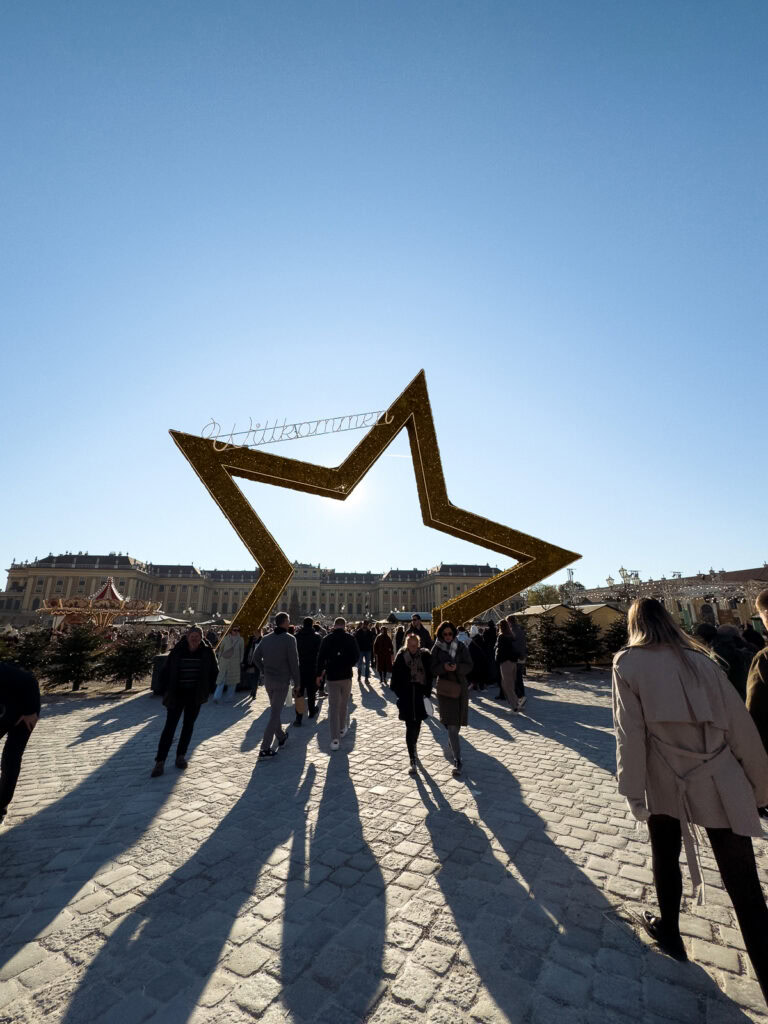
Are European Christmas markets free?
Yes, most Christmas markets in Europe are completely free to enter. You can wander around and enjoy the festive vibes without paying a cent.
If you want to eat, drink, shop or take part in activities like ice skating then obviously you’ll need to pay extra.
There are a few noteworthy markets in Europe that do cost to enter though, like London’s Winter Wonderland at peak times (it’s free off-peak) or the market area at Copenhagen’s Tivoli theme park.
Do I need cash for Christmas markets?
It depends on the country, but yes, it’s probably smart to carry some cash with you. Many markets will have stalls that take card but smaller stalls, especially at more local markets, might be cash only.
Most markets will have ATMs clearly signposted but these might have a long line and a nasty transaction fee 🫠
Can you haggle at Christmas markets?
Haggling is not common or expected at most European Christmas markets, and if you try to negotiate the price in places like Germany, Austria or France then you miiiight be met with anger.
If you’re visiting markets further east, like Prague or Budapest, and you’re buying lots of items from one stall or you’re visiting at the end of the day right before they close, then you could try your luck to ask for a deal. They might still say no, but haggling at local markets in these places is more common so you probably won’t offend anyone.
What do people do at Christmas markets?
There is actually so much to do at the good Christmas markets! Soak up the festive magic, indulge in seasonal food and drinks, enjoy musical performances, go ice skating, search for the best light displays, shop for memorable souvenirs, and collect the unique Glühwein mugs from different markets.
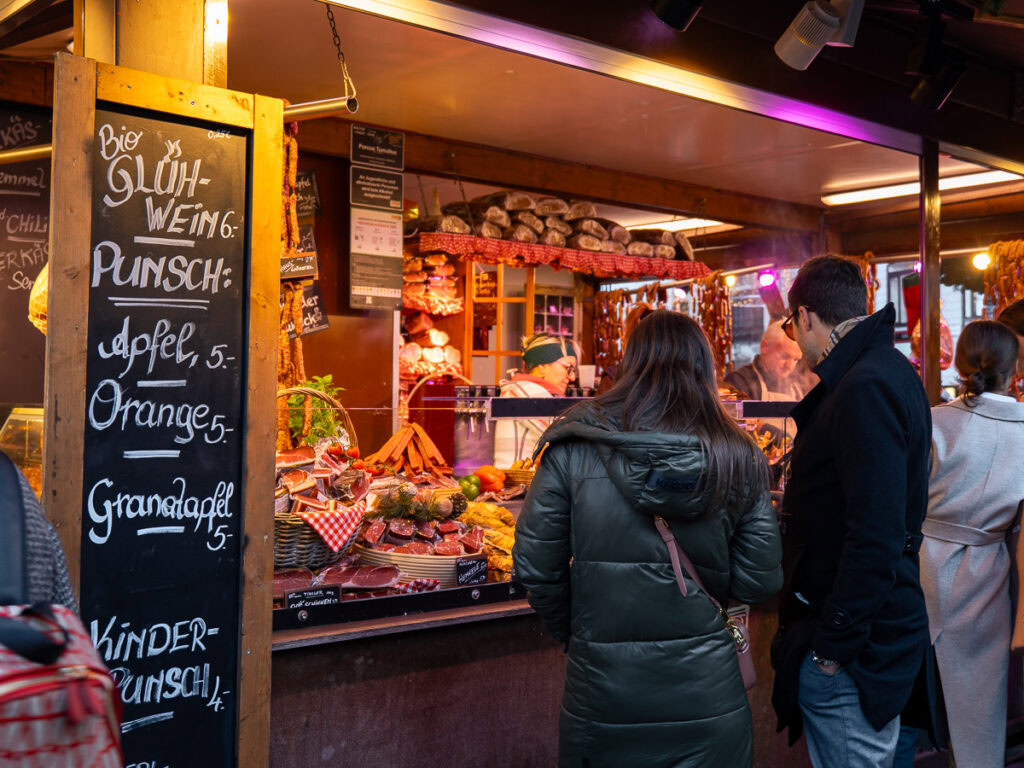
When do European Christmas markets start and end?
All markets have their own dates but most of the major Europe Christmas markets start in mid to late November and run until just before Christmas, and most markets are open 7 days a week. Some might start and finish earlier or later, some smaller markets might only run on weekends.
Markets typically start on a Friday or Saturday and opening weekend will be busy busy busy, then they get a bit quieter from the first weekdays, gradually building up until the week before Christmas.
What should you wear to the Christmas markets?
Layers are key! Climate and conditions will depend on where you are but all the cities/towns I’ve recommended could be chilly, rainy or snowy.
Waterproof boots and a raincoat are essential, take thermal base layers to stay warm, and rug up with a scarf, hat and gloves.
Are Christmas markets suitable for kids?
For sure! Most Christmas markets are very family-friendly, with small rides, ice skating rinks, kid-friendly treats and performances to keep little ones entertained.
Is it safe to visit Christmas markets as a solo traveller?
Christmas markets are generally safe for solo travellers, but they can get super crowded so just take the usual precautions of being in a busy public place. Keep belongings secure in a zipped cross-body bag, don’t leave your phone or camera sitting on a table, and if you’re indulging in Glühwein then just keep your wits about you.
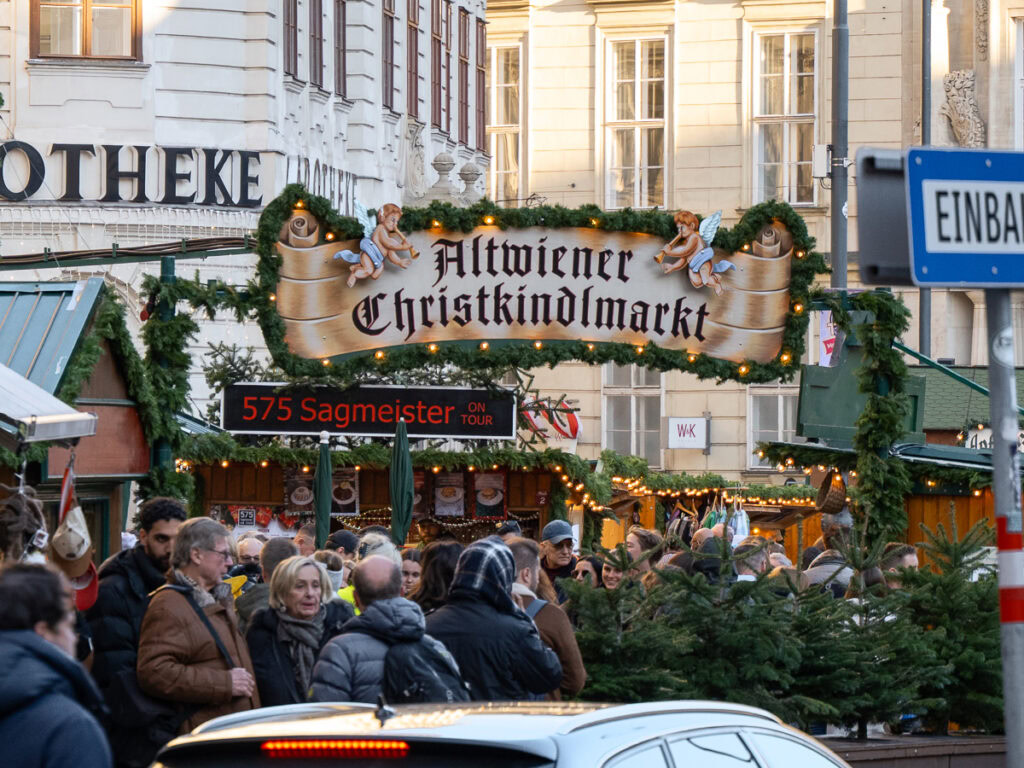
And that’s a wrap on the ultimate European Christmas market itinerary by train! Whether you’re most looking forward to sipping Glühwein in Cologne, ice skating in Salzburg, snagging a bargain in Prague or admiring the over-the-top window displays in Strasbourg, I hope this guide helps you plan your dream festive adventure.
If you’ve got any questions about specific stops, rail passes or budget concerns then drop a comment below or flick me a message on Instagram @findingalexx. And if you’re planning your trip now, don’t forget to check out my other Europe guides for more detail on getting around without flying + loads of other itineraries.
MORE EUROPE ITINERARIES:
- Europe in two months: The ultimate itinerary
- My exact Eurail itinerary
- How to spend 5 days in Switzerland
- How to spend 10 days in Switzerland
- How to spend 1, 2 or 3 weeks in Northern Italy & Switzerland
- How to spend 3 weeks in Scandinavia
- How to spend 2 weeks in Poland
MORE EUROPE TRAIN GUIDES:
- How to use a Eurail Pass
- Is a Eurail Pass worth it?
- Should you buy a Swiss Travel Pass for your Switzerland trip?
MORE EUROPE TRAVEL INSPIRATION:
MY GO-TO TRAVEL PLANNING RESOURCES
Flights ✈️ I use Skyscanner to find the best flights for my trip and then I’ll always book direct with the airline to protect myself from having to deal with dodgy third parties if anything goes wrong.
Trains 🚂 If I’m travelling through Europe, I try to travel by train wherever possible! For an extended trip (2+ weeks) I’ll calculate if a Eurail Pass is worth it, or I’ll book point-to-point tickets through RailEurope or the local train operator.
Accommodation 🛎️ I book almost all of my accommodation through booking.com, they have a user-friendly website + app and many of their options are free cancellation, easily cancelled with a simple click of a button.
Activities 🗽I use GetYourGuide, Klook and Viator to look for activities in the places I visit, or I just Google ‘things to do in [city]’! P.S. If you book anything on Klook you can use the promocode FINDINGALEXXKLOOK to get 10% off
Travel cards 💳 I’m a Wise gal through and through, they’ve been my chosen travel card for more than five years now. You can easily top up your card from your bank account or through Apple Pay, convert your money to local currency, and spend money with minimal fees and the best exchange rates around.
Travel insurance 🩺 I use Cover-More NZ travel insurance for my own trips, I have a comprehensive policy and I’ve only had good experiences with them. Cover-More also has an Australian company, but if you’re from elsewhere then two popular insurance options for global travellers are SafetyWing (cheaper policy, lower coverage) and World Nomads (more expensive but significantly better coverage).
Luggage 💼 I travel with Samsonite Cosmolite suitcases, one 75cm check in bag and a 55cm carry on bag, and I absolutely adore them and will never travel with anything else! They are SUPER lightweight (2.8kg and 1.9kg respectively) so I have much more space for my actual stuff.
Camera gear 📸 I use a iPhone 15 Pro Max for phone photos/videos, and my camera kit includes a Lumix S9 (incredible lightweight full-frame camera, a game changer for travel creators!) with a 20-60mm lens, a Lumix G9 with an 8-18mm and 12-60mm lens, a DJI Mini 3 Pro drone and a GoPro Hero 10. I do all my writing and editing on my ASUS Zenbook 14, it’s lightweight but powerful enough for photo editing and intense blogging sessions.

Really enjoyed reading your blog. It was very informative. What would you recommend for a 10 day trip. I am kind of a WWII buff, so I would like to see a little more of Nuremberg and Dresden.
Thankyou
WWII travel is a bit out of my wheelhouse but with ten days around Xmas if you’re happy to move every two days you could do a Germany/Czechia/Austria combo with Vienna > Prague > Dresden > Nuremburg > Munich 🙂
I would love your help planning our honeymoon –
we do have 2.5 weeks – and we need 5 days in st.gallen and luzern as i have family there – any advice or route help would be incredible !
Hey Andrea! I’ve just published a 10 day Switzerland itinerary that includes both St Gallen and Lucerne which might be helpful: https://findingalexx.com/10-day-switzerland-itinerary/
You could easily do a Switzerland + Northern Italy loop including Zurich, St Gallen, Lucerne, Interlaken + Jungfrau region, Zermatt, Glacier Express train, St Moritz, Bernina Express train, Tirano, Milan, from there you have easy options to reach Cinque Terre, Florence, Rome, Lake Como or Portofino, then you could train back to Zurich to fly out.
Hi Alexx!
Thank you for sharing this very detailed adventure of yours. How was the weather throughout? Was it manageable? We come from a tropical country. We have been to places like Canada and Japan where we had some considerable snowy weather, but I am thinking nothing comes close to what we are about to venture into. Thank you!
Hey Maria! You’ll need warm clothes for sure, but it wasn’t alpine-level cold in all of these destinations. Manageable with good layers and warm scarves, beanies and gloves, I had snow in quite a few places but it was magical, light snow rather than crazy snow dumps which cause havoc. Alpine towns like Salzburg, Innsbruck, most places in Switzerland can be much colder than the others, so be prepared for that.
Hi guys!
My fiancée and I are traveling to the Christmas Markets from Dec 5-16.
We are going to Zurich, Munich, Nuremberg, Salzburg, Strasbourg, Colmar, Paris. I have attached Itenary below.
Staying in Zurich/ Munich/ Strasbourg, and Paris… with day trips to the other locations.
I was wondering on recommendations as far as travel is concerned. We are planning on getting Eurail pass as we will be taking day trips to some of these locations.
Any other recommendations would be greatly appreciated!
Hey Luke! What travel recommendations specifically are you looking for? Are you wanting to know what trains to catch/routes to take?
More so if uou recommend getting the Eurail pass or point to point trains.
We are going to take trains everyday so leaning towards the Eurail… but wanted to get your professional opinion!
Thanks!
It’s impossible to say what option will end up being cheaper without knowing your exact movements as you need to calculate the point-to-point ticket costs, but personally I prefer a Eurail Pass because it’s MUCH more flexible, for Switzerland/Austria/Germany you can just take any train on a designated Eurail ‘travel day’, no need to reserve seats in advance. France is a little different and high speed trains need reservations with a Eurail Pass.
If you want to know the best value option then you can see how I calculate Eurail Pass options here: https://findingalexx.com/is-a-eurail-pass-worth-it/
Hi! That sounds so fabulous. Is it possible to stay in a central location and hit several markets over the course of 7-10 days? I’m thinking packing up luggage every day to move to a new hotel sounds exhausting.
It would probably be best to split your time between two destinations as this will give you more range, you could spend 4-5 days in Cologne and visit Dusseldorf, Brussels, Bruges, Ghent, Antwerp, Frankfurt, then you could move to Strasbourg for 4-5 days and do the markets around there + Basel.